

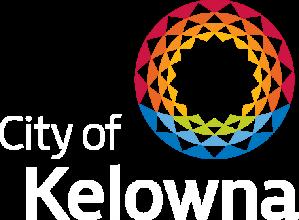







FOR THE YEAR ENDED DECEMBER 31, 2024
The Annual Report is produced by the Corporate Services Division of the City of Kelowna in cooperation with all civic departments. Kelowna, British Columbia, Canada
As I reflect on the year 2024, I am excited about the progress we have made in delivering on the priorities that matter most to the people of Kelowna. From enhancing community safety to investing in infrastructure and housing, to building a strong local economy, this year has been a testament to what we can achieve when we work together. Kelowna is growing quickly, and we are making thoughtful, strategic decisions today to ensure a stronger, more sustainable city for generations to come.
As mayor, I have had the privilege of working with a Council committed to advancing the needs of our residents, businesses, and the broader community. Guided by our Imagine Kelowna community vision, Council priorities and the voices of our community, we have continued to make strategic investments in priority areas such as:
• Crime and Safety
• Affordable Housing
• Homelessness
• Transportation
• Agriculture
• Climate and the Environment
• Economic Development
By building strong partnerships with the Province of BC, the Government of Canada, community organizations, and the private sector, we have been able to secure the necessary funding, resources, and support for important programs and projects to improve quality of life for our residents.
One of the most important milestones of 2024 was the introduction of our first-ever service-based budget. By organizing the budget around services rather than departments, we have increased transparency and accountability, helping residents better understand where their tax dollars go and what outcomes they achieve. This new model is allowing us to deliver infrastructure faster all while maintaining one of the lowest property tax rates in the province.
With Kelowna being one of the fastest-growing cities in Canada, the need to deliver infrastructure has never been more urgent. In 2024, we advanced some of the most ambitious capital and infrastructure projects in our city’s history to improve our recreation facilities and transportation systems, in alignment with our 2040 Official Community Plan. These investments are crucial in supporting the growth and development of our city, ensuring that Kelowna remains a vibrant and connected community.


Tackling complex and urgent issues such as safety, housing, and homelessness remains a top priority for this Council. In 2024, we added more RCMP officers to our community, expanded supportive housing with additional tiny homes, and introduced new tools to cut red tape and speed up building permits making it easier and faster to build the housing our community needs.
While we made progress in advancing our priorities in 2024, we know there is more work to do to make Kelowna the best place to call home. As we look ahead to 2025, our focus remains on building a city that is safe, affordable, and built for the future. Our preliminary budget reflects that vision, with continued investments in public safety, infrastructure, and essential community services.
Thank you for your continued trust and support. Together, we will continue building a Kelowna that is a better place to live, work, and raise a family.
On behalf of the City of Kelowna Senior Leadership Team and Council, I am pleased to present the 2024 Annual Report, an important yearly snapshot of the activities undertaken throughout the year to enhance the wellbeing and prosperity of our community for years to come
As City Manager for the past seven years, my role has been to empower our City staff to deliver their best and bring the community’s vision to life. Our core values innovate to make things better, act as one team, serve proudly, and lead responsibly guide our daily actions and how we approach our work.
In 2024, our corporate priorities were a driver for a heightened commitment to transparency, accountability, and providing exceptional value to our residents. We focused on aligning our budget processes with service priorities, expanding our digital tools to enhance service capacity, and fostering leadership skills among our staff. These priorities ensure that we remain a highperformance organization that delivers excellent value for money to our residents.
The dedication and hard work of our staff have been instrumental in achieving our goals. From launching our inaugural service- based budget, to accelerating investments in transportation and other capital projects, to delivering quality services that citizens expect of us and doing it all in ways that improve efficiency and effectiveness, our team has consistently demonstrated a commitment to excellence. Our efforts have been recognized through various awards and accolades, showcasing the outstanding work of our capital planning, financial services, and infrastructure teams.
In our pursuit of becoming more efficient, we continue to embrace digital transformation. Leveraging technology has allowed us to create more accessible and efficient services for residents and businesses. This digital shift has not only improved how citizens interact with the City but also streamlined our operations, making us more responsive and effective in addressing the needs of our community.


Doug Gilchrist City Manager, Kelowna
Our commitment to fiscal prudence also remains at the forefront of everything we do. We have maintained a low and competitive tax rate while identifying efficiencies totaling $3 million to be redeployed to priority areas. By generating the majority of our revenues from sources other than property taxes, we have minimized the tax burden on our residents and ensured the sustainable growth of our city. Our strong asset management program, healthy financial reserves, and low debt levels have positioned us well to navigate economic challenges and continue delivering high-quality services
Looking ahead, we remain dedicated to building a stronger, more resilient Kelowna. Our focus on active financial management, digital transformation, and service-based budgeting will guide our efforts to meet the evolving needs of our community. Together, we will continue to innovate, collaborate, and lead responsibly to create a city that makes us all proud.


We acknowledge that our community is located on the traditional, ancestral, unceded territory of the syilx Okanagan people.
Kelowna is growing fast. In 2024, we continued to be one of Canada's fastest-growing communities. As we prepare to welcome another 50,000 new residents about 30 per cent more by 2040, we’re making targeted investments to embrace change and make life better for both today and tomorrow
These investments aren't just about improving City services and infrastructure; they're also about optimizing our business practices and financial management.
In 2024, we made significant strides in:
• Infrastructure delivery by accelerating projects to improve mobility, create community spaces, and enhance quality of life.
• Service delivery by investing in safety and inclusivity to ensure all residents feel secure and welcome.
• Financial efficiency and transparency by implementing innovative budgeting and performance measurement techniques to better showcase the value and purpose of government services.
At the heart of these investments is our commitment to creating a city where people want to live, work, study, visit, and invest both now and for generations to come.
Infrastructure delivery: big projects, realized
Kelowna's rapid growth over the past decade has enabled the City to raise funds through development cost charges and other tools, with minimal impact on taxes. This has put us in a strong position to deliver on key projects and that's exactly what we've done. In 2024, we increased capital delivery by 53 per cent over the previous year.
Key City projects in 2024 focused on:
• Keeping Kelowna moving through investments in transit infrastructure, sustainable transportation, and shared mobility;
• Creating spaces for community through early-phase investments in the Building a Stronger Kelowna suite of recreational facilities to provide places for people to move, learn, grow, connect, and socialize;
• Expanding the capacity of the Kelowna International Airport to welcome passengers and provide a worldclass experience in Canada’s ninth busiest airport, with construction starting on an 8,000-square-foot terminal expansion; and
• Enhancing the quality of outdoor facilities and greenspaces with targeted investments in neighbourhood parks and tourism landmarks such as the Water Street boat launch and the Knox Mountain lookout.
These projects were made possible not only through healthy financial reserves but also an innovative procurement strategy: the bundling of smaller projects together to attract larger construction firms to Kelowna and deliver efficiencies of scale. As a result, projects were delivered more quickly and at lower cost, while the community benefited from more local jobs.

Our 2024 Citizen Survey made it clear: our citizens want us to invest in the services and initiatives to make Kelowna a safer, more inclusive, more connected community. We listened and took action.
Key service highlights in 2024 included:
• The creation of a new Social Development department to enhance social wellness and respond to complex social issues including homelessness;
• Keeping community safety top of mind by funding new positions in RCMP, Bylaw, and Fire, improving response time and maintaining higher visibility in the community;
• Working closely with provincial and community partners to develop diverse forms of housing and social supports for every walk of life; and
• Laying the groundwork for the most ambitious capital and infrastructure projects to date, such as the Building a Stronger Kelowna suite of recreational facilities going beyond just bricks and mortar to leave a lasting legacy for generations to come
In addition, the City of Kelowna continued to deliver a wide array of services that citizens have come to expect, including essential utilities like water and wastewater management, core infrastructure such as roads and bridges, and community services like parks and recreation
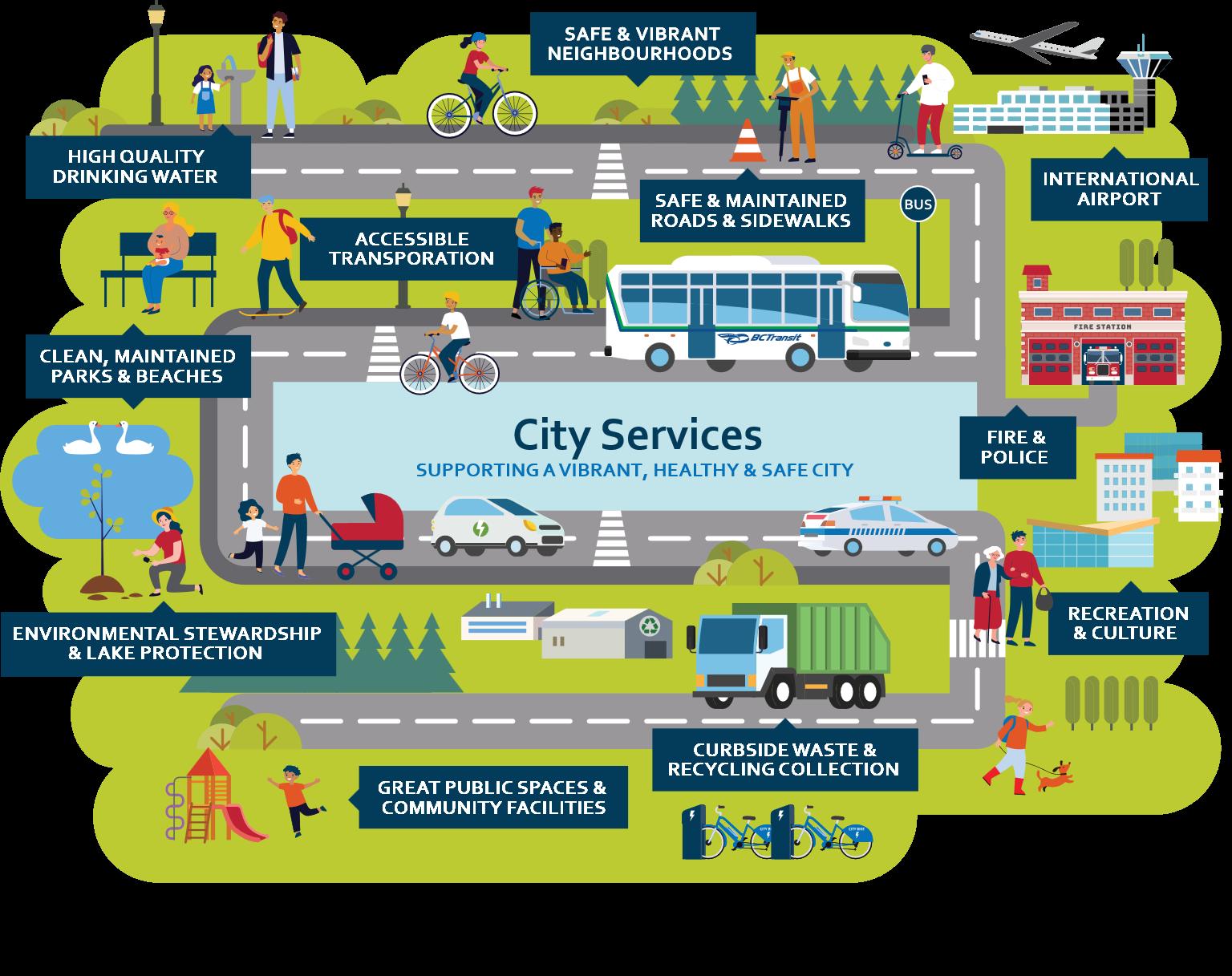
In 2024, the City of Kelowna implemented an innovative approach to budgeting known as service-based budgeting, a transformative process that outlined the City’s services in 19 categories complete with performance measures. The approach was a paradigm shift in the way Council and citizens could see what goods and services we purchase with taxpayer money.
The inaugural service-based budget allowed the City to:
• Shift the focus from traditional line-item expenditures to services with measurable outcomes;
• Improve responsiveness and efficiency by helping Council decide between wants and needs, and allocate resources to meet the needs of the community; and
• Increase transparency about where taxpayer money is spent and the trade-offs if other services are prioritized.
Service- based budgeting will continue to improve the City’s accountability about how taxpayer funds are used. As more data becomes available to show tangible results for the money invested, Council and residents will be better able to make data-informed decisions and shape the city’s future The City’s ongoing participation in the Municipal Benchmarking Network Canada program will help us compare ourselves with other towns and cities and foster a culture of service excellence in municipal government.
The move to service-based budgeting would not have been possible without the City’s commitment to digital transformation a willingness to use data and tools in new ways to increase efficiency, accountability, and transparency.
Our efforts in 2024 and beyond remained true to the Imagine Kelowna vision, which acts as a compass for the city’s evolution and an anchor for City policies and big picture plans like Kelowna’s Official Community Plan. Our work was also grounded in our strategic plans and Council and corporate priorities, and responsive to the needs of our community
As we look forward, our commitment to prudent financial management, quality service delivery, and accelerated capital investments will continue as we build the City of the Future.
For more information about projects above and so much more, see our Council Priorities and Corporate Priorities sections.




In 2024, the City of Kelowna made notable progress in improving community safety, housing, and infrastructure. The City reduced property crime rates, enhanced law enforcement, and supported affordable housing initiatives. Additionally, Kelowna launched programs to expedite infrastructure projects and promote climate resilience.
These achievements reflect the City's dedication to creating a safer, more inclusive, and sustainable environment for its residents.
Kelowna is a vibrant mid-sized city located in the southern interior of British Columbia, Canada. One of the fastest growing cities in the country, it is situated in the heart of the Okanagan Valley, surrounded by mountains, lakes and vineyards. With a population of more than 165,000 people, it is the largest city in the Central Okanagan.
Kelowna’s diverse economy includes a mix of industries such as agriculture, manufacturing, retail trade, construction, technology, healthcare and tourism. The region is renowned for its wine industry and is home to a top-ranked college and university, a world-class teaching hospital, the second largest trade school in the province, and Kelowna International Airport, one of the largest economic drivers in the Southern Interior and the largest municipally-owned airport in Canada.
Source: 2024 Environics data
A growing hub for technology and aerospace-related companies, Kelowna is fast becoming an economic powerhouse and remains one of the area’s most soughtafter tourist destinations.
Kelowna’s natural environment is a cornerstone of its identity, supporting the community’s health, economy, and livability. The city offers numerous parks, trails, beaches and recreational facilities, which provide a range of activities for residents and visitors, including hiking, biking, golfing, swimming, and boating.
This, coupled with a diverse economy and vibrant arts and culture scene featuring multiple festivals and events throughout the year, bolsters a strong sense of community and high quality of life.
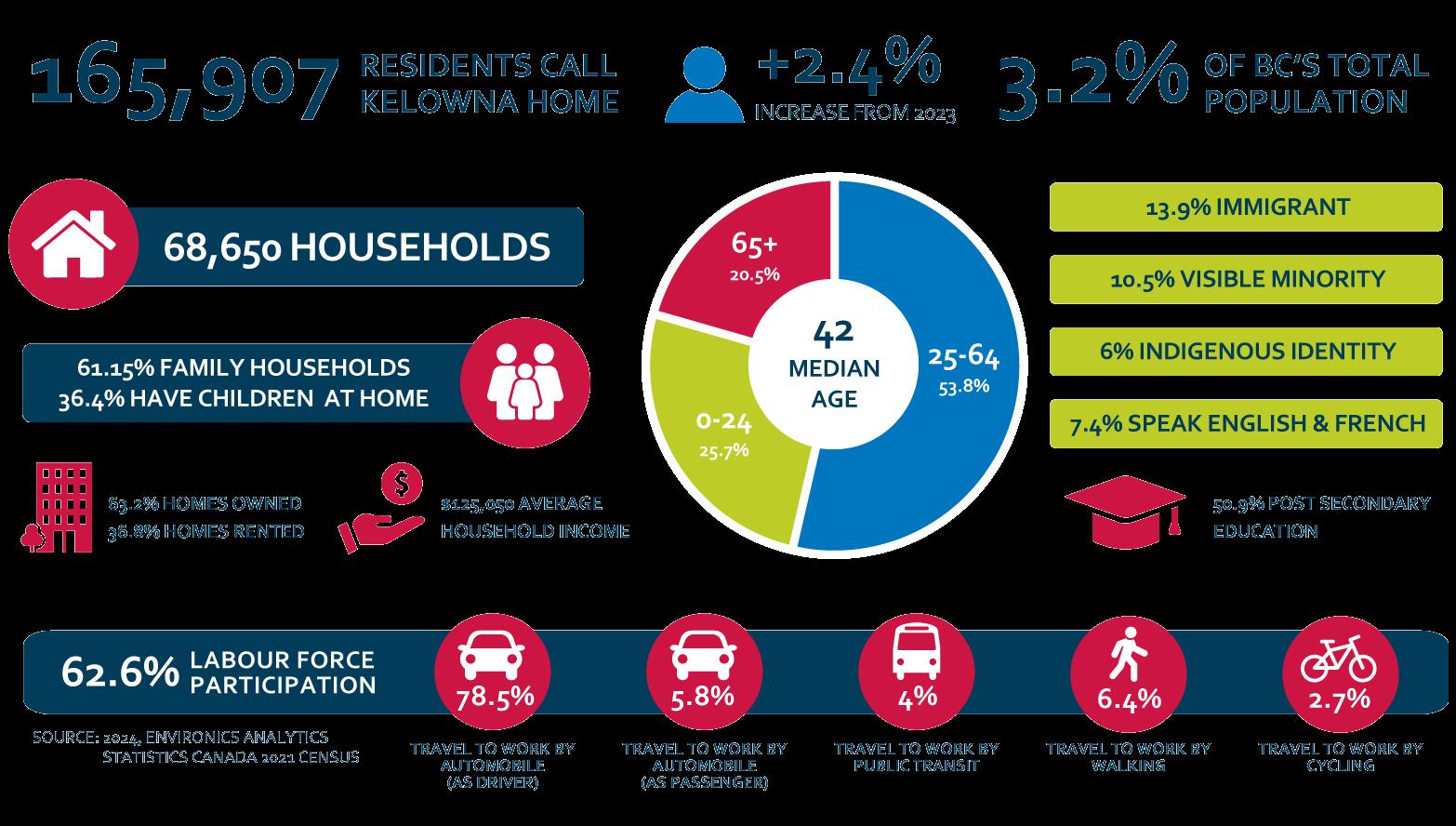
The City of Kelowna has conducted a biennial citizen survey for more than a decade. The survey provides a stable, ongoing measure of how residents feel about life in the city, their priorities for the future of the city and their satisfaction with the municipal services, programs and facilities the City provides.
Results are benchmarked against other B.C. municipalities where possible to help us understand how we measure up to other cities. The responses are weighted by age, gender and city-wide distribution to accurately reflect Kelowna’s population. Insights gained by this research help us make important decisions regarding planning, budgeting and service improvements.
To learn more, visit kelowna.ca



The 50th Annual Civic & Community Award honours individuals and organizations for outstanding contributions and achievements in 2024 that directly benefited our community.
Clayton Gall Citizen of the Year Fred Macklin & Sarah Donalda-Treadgold Memorial Award
Pam Turgeon and Shadia Doty
Anita Tozer Memorial Award bestowed by Mayor and Council
Ainsley Wood Young Citizen of the Year Award
Tyson Cook (Freida Whales) Honour in the Arts Award
Almendra Osorio
Teen Honour in the Arts Award
Special Olympics Kelowna Central Okanagan Foundation Volunteer Organization of the Year Award
Valley First, a Division of First West Credit Union Corporate Community of the Year Award
Beverley Kalmakoff Champion for the Environment Award
Bill Franzman
Bob Giordano Memorial Award Coach/Sport Administrator of the Year
OKM Sr. Girls Volleyball Team
Bryan Couling Memorial Award / Athletic Team of the Year
Kylie Taylor Athlete of the Year Award – Female
Jerome Blake
Male Athlete of the Year Award – Male
Maya Andruchow
Augie Ciancone Memorial Award – Young Female Athlete
Dominic Sodaro
Augie Ciancone Memorial Award – Young Male Athlete
The City of Kelowna is a municipality located in the southern interior of British Columbia. Governed by the Community Charter and Local Government Act, the nearly 1,300-employee-strong organization is responsible for providing essential services, including clean drinking water, wastewater systems, landfill and waste management, parks and recreation, fire protection, transportation, community planning and environmental stewardship.
Taking into account operational costs and capital requirements for future growth and community needs, the City’s annual budget is nearing $900 million.
The City is committed to generating its own source revenues and partnerships. On average, only approximately 25 per cent of the City’s budget is funded through annual taxation. Other revenue sources include reserves, grants, user fees and income from self- funding business units including Kelowna International Airport and the City’s water utility and solid waste operations. Through strong financial management, the organization’s goal is to maintain, grow and improve local infrastructure and community services, and ensure a high quality of life for citizens.
Council Priorities 2023–2026 identifies the strategic shifts, improvements and changes that are important to Council, the community and the organization. The public Progress Report at opendata.kelowna.ca is an interactive online report showing how the City is taking action and making progress, demonstrating Council’s commitment to transparency and accountability.
Working together with the Annual Report to keep the public informed of City projects and progress are the City’s website (kelowna.ca), email newsletters, and a variety of social media channels designed to spark conversation and connections with our community.
Citizens can also provide input and be involved on key projects through the City’s online engagement platform getinvolved.kelowna.ca. Engaged citizens help build strong neighbourhoods and create a city that is welcoming and inclusive.
CORPORATE SERVICES
Joe Sass General Manager INFORMATION TECHNOLOGY
James McGregor Chief Technology Officer
INFRASTRUCTURE
Mac Logan General Manager
PEOPLE & PROTECTIVE SERVICES
Stu Leatherdale General Manager
ACTIVE LIVING & CULTURE
Jim Gabriel Divisional Director
PARTNERSHIPS & INVESTMENTS
Derek Edstrom Divisional Director
PLANNING, CLIMATE ACTION & DEVELOPMENT SERVICES
Ryan Smith Divisional Director
OFFICE OF THE CITY CLERK
Laura Bentley City Clerk
COMMUNICATIONS
Lisa Corcoran Director
KELOWNA INTERNATIONAL AIRPORT
Sam Samaddar CEO
HUMAN RESOURCES
Heidi Obermeier Director
The City of Kelowna has received many awards that highlight our efforts to make Kelowna a City of the Future. For a full list of awards, visit kelowna.ca/awards
Canadian Award For Financial Reporting presented by Government Finance Officers Association
2023 Annual Report
City was recognized for excellence in governmental accounting and reporting for the 22nd consecutive year.


Distinguished Budget Presentation Award presented by Government Finance Officers Association
2024 Financial Plan
City was recognized for excellence in governmental budgeting for the 23rd consecutive year
Community Excellence Award for Asset Management presented by Union of BC Municipalities
Asset Management
City was recognized for its use of a Computerized Maintenance Management System, called CityWorks, to manage assets.
Community Excellence Award presented by the Southern Interior Local Government Association
Social Responsibility
City was recognized for its PEOPLE (Paid Employment Opportunities for People with Lived Experiences) Peer Navigator and Capacity Building program.
Excellence Awards presented by Municipal Service Delivery Officials
Excellence in Innovation
City was recognized for its Building Permit AI Chatbot.
Awards for Excellence in Planning presented by the Planners Institute of BC
Silver Award for Research & New Directions in Planning
City was recognized for its Our Housing Needs Assessment 2021-2031.
The City of Kelowna is guided by an elected mayor and eight councillors for a four-year term (2022–2026). Led by Mayor Tom Dyas, Kelowna City Council is committed to being open for opportunity through community engagement and partnerships. It is consistent and transparent in decisions, creating a favourable environment for customer service, development, and business in Kelowna. Council meets regularly and the public is welcome to attend any open meeting or provide feedback in writing via mail or email. Learn more at kelowna.ca/council
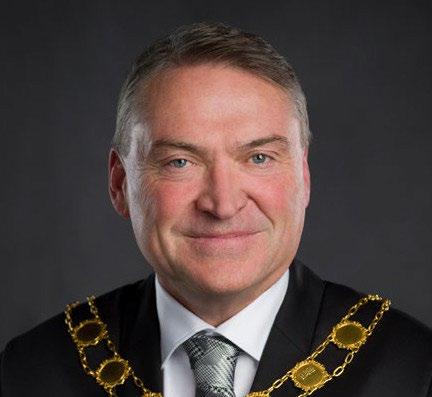








Council and Corporate Priorities are the strategic shifts, improvements and changes Council and our organization want to deliver to citizens. They are in addition to the essential services the City provides every day from first responders and clean drinking water to safe roads and recreation. Explore detailed actions and achievements in our Council Priorities and Corporate Priorities sections.
and traffic flow is enhanced on major road corridors. Increased engagement and support for the agriculture industry.
A reduction in corporate and community greenhouse gas emissions.
Priority sectors for economic diversification are supported.
More protected and restored natural areas. The number of businesses is increasing.
A climate lens is applied to City decision making. The city has a sufficient supply of suitably located and serviced employment lands.


Council has identified seven priorities to business and spending decisions during their four-year term: Crime & Safety, Affordable Housing, Homelessness, Transportation, Agriculture, Climate & Environment, and the Economy.
Citizens can view a detailed progress report on Council priorities at opendata.kelowna.ca
Representing nearly 40 per cent of the City’s 2024 operating budget, crime and safety is the number one priority for Council, residents and the business community.
In 2024, the City took decisive action to strengthen residents’ sense of safety, reduce crime, and enhance the wellbeing of our community. Early in the year, Council adopted the recommendations from the Mayor’s Task Force on Crime Reduction. Recommendations helped address gaps and challenges in the community and contributed to a 10% decrease in property crime, with notable reductions in business and residential break & enters. The City also leveraged the 1% Public Safety Levy introduced in 2023 to hire more RCMP officers, bylaw officers, and firefighters.
Simultaneously, the City’s advocacy efforts targeted senior levels of government, urging support for health and justice initiatives, including complex care, integrated crisis response teams, bail reform, and an increase in Crown prosecutors. The City continued to advance the “upstream” Community Safety Plan with provincial government partners and more than 40 nongovernmental organizations across the city. Throughout 2024, the City leveraged provincial and federal grant programs, including the Building Safer Communities Fund to reduce youth gang involvement and offset expenditures for public safety related programs and operations.
A purposeful increase of police and bylaw presence in downtown and Rutland, as well as Crime Prevention Through Environmental Design (CPTED) audits delivered by Community Safety staff, continued to be a focus throughout the year. Taken together, these efforts helped stabilize citizen’s sense of safety as measured by the 2024 Citizen Survey.
While Kelowna is a safe place to live, work and raise a family, continued investment in public safety to catch up and keep up with the increasing demands of our rapidly growing city remains critical to our quality of life. The City and its partners remain committed to reducing the risk of crime and increasing citizens’ sense of safety.
Learn more at kelowna.ca/communitysafety
COUNCIL PRIORITY: CRIME & SAFETY
Key Actions and Achievements
Crime Reduction
• In early 2024, Council adopted the recommendations made by the Mayor’s Task Force on Crime Reduction Progress was made on a majority of the 19 initiatives, including the expansion of Business Improvement Area ambassador program.
• Property crime decreased in 2024. In September, the RCMP reported a 10% reduction in the overall property crime rate, including a 31% decrease in business break & enter (B&E) and 15% decrease in residential B&E compared to the same period in 2023
• Thanks in part to the Public Safety Levy introduced in 2023, the 2024 budget added 16 RCMP officers, five bylaw officers, and six fire fighters to bolster first response and community safety.
• Kelowna RCMP’s Repeat Offending Management Program, alongside the provincial Repeat Violent Offender Intervention Initiative, were operationalized fully in 2024 to offer extra support to repeat offenders. These efforts focus investigative and enforcement efforts on the minority of offenders committing the majority of property crime in Kelowna
• Advocacy continued with the provincial and federal governments for stricter accountability and bail reforms for repeat property offenders, as well as increasing local Crown prosecutor resources.
• Numerous initiatives launched to expand Crime Prevention Through Environmental Design (CPTED) including a Safe in 60 CPTED video series, increased CPTED audits in business and residential (strata) settings, as well as training for a City-cohort of practitioners to increase audits in the next few years.
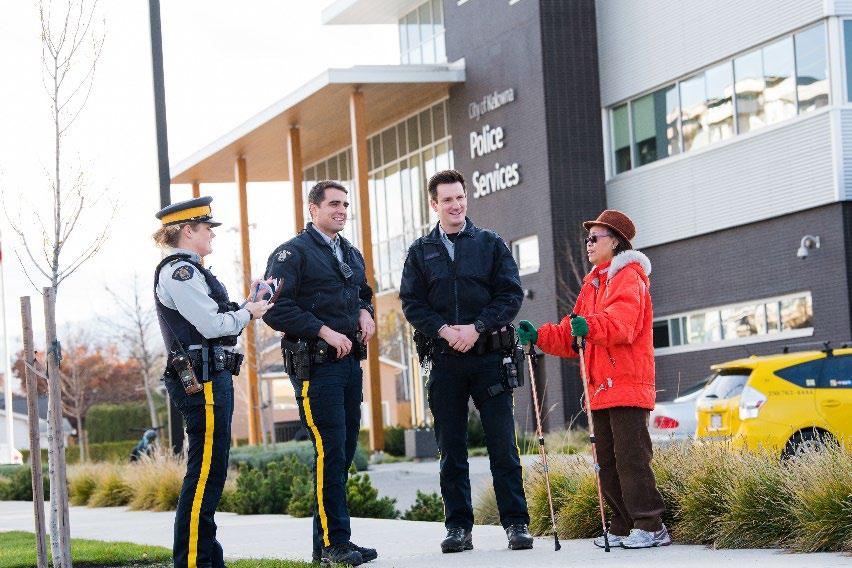
• The 2024 Citizen Survey showed a stabilizing sense of safety among residents.
• The City continued implementing the five-year Community Safety Plan with community and provincial partners, which started in mid 2023. By December 2024, eight of 30 actions were complete and six were underway with engagement from 55 community organizations and members.
• Among the success of the Community Safety Plan is the creation of an alternative, community-based / non-police response model for people experiencing crisis. Funding to operationalize the model is being actively pursued.
• The Canadian Centre for Safer Communities selected the City of Kelowna as one of 10 pilot cities for the Community & Urban Safety Monitoring Project. This project offers guidance, tools, and training on evaluating and monitoring our local Community Safety Plan while creating a cross-Canada support network.
• Block Connectors (Strong Neighbourhoods) Program increased to 73 in 2024 from 67 in 2023, encouraging community-based solutions to improve safety and build connection.
• Federal grant awarded from Building Safer Communities for $1.8M to collaborate with School District #23 to implement a Youth Gang Reduction and Prevention Strategy.
• The bike valet program expanded significantly in the summer to provide safe bike storage for cyclists Bicycle loan-a-lock programs also expanded to Parkinson Recreation Centre and Tourism Kelowna.
• In 2024, Council formally established traffic enforcement visibility among police priorities. As a result, RCMP re-prioritized traffic enforcement and re-established its volunteer SpeedWatch Program.
• Variable speed signage boards were deployed on major incident routes to calm traffic.


In the last five years, home prices in the Central Okanagan have risen by more than 50 per cent,* with the average home price in Kelowna now sitting at just under $1 million. Unaffordable home ownership has cascading effects across the housing system, raising demand and prices for rental housing, ultimately making all housing forms less affordable.
The role of a well-functioning housing system is a critical factor in creating healthy, diverse and vibrant neighbourhoods. A growing, thriving community like Kelowna needs a wide range of housing types to meet the needs of residents at all stages of life, including students, young families, seniors, and everyone in between.
Our housing supply must also meet the demands of a rapidly growing population. Kelowna is one of the fastest growing and sought after communities in Canada. Without an adequate supply and diversity of housing, the community’s housing challenges will persist.
There are many factors outside of the City’s control, such as interest rates; housing market dynamics; and land, construction and labour costs. However, we are pulling all the levers within our sphere of influence such as development regulation and processing, as well as incentives to affect change and meet our goal to improve housing affordability for our residents.
In 2024, the City issued $2.4 billion worth of building permits up 33 per cent from 2023 for a total of 5,120 new homes. Multi-unit housing continued to lead the way, with apartment housing making up the majority.
The City has also worked hard to create a development environment that is highly supportive of rental housing. Tax incentives, regulatory incentives like reduced parking requirements, and grants have all combined to attract the highest level of investment in purpose-built rental housing in Kelowna’s history. The vacancy rate in Kelowna had steadily climbed to 3.8 per cent from 1.3 over the year.
Vacancy rates were also influenced by the City’s continued restrictions on short term rentals (STR) Taken together with the City’s focus on infill housing and transit-oriented development, these changes are moving the home affordability needle in the right direction.
For more information, visit kelowna.ca/housing.
Key Actions and Achievements
• In February 2024, the City presented the Middle Income Housing Partnership (MIHP) model to Council. The MIHP leverages the $31.5M Housing Accelerator Fund grant secured in 2023 to deliver new affordable rental housing projects with a minimum of 20% of units that are 20% below market rate. This funding will be spent over the course of three years to improve the supply and diversity of housing, including items such as supporting development along transit corridors, acquiring land, and exploring new partnerships for affordable housing.
• MIHP launched two pilot projects to create 160 to 200 units ready for move-in in 2025. These include 75 new homes in the North End neighborhood for seniors, families, people living with disabilities and individuals with low-to-moderate income
• The City also introduced a new fast-track housing program to accelerate development of infill housing such as 4-plexes and carriage houses.
• Part of the Housing Accelerator Fund also expanded the City’s Rental Housing Grants program and incentivized up to 341 units of affordable long-term rental housing by offsetting Development Cost Charges (DCCs).
• In late 2024, the City presented an interim Housing Action Plan report to Council. The plan defined objectives and actions to diversify housing supply, minimize the period of homelessness, and partner effectively with community housing providers and funders. The plan builds on the City’s award-winning Housing Needs Assessment completed in 2023.
*Source: Association of Interior Realtors
Homelessness is not unique to Kelowna but is presenting as a dynamic and rapidly changing problem locally and across Canada. It poses a complex and pressing societal challenge, significantly impacting individuals, communities, and businesses. While the City continues to advocate for the necessary health and housing supports from senior levels of government, we have assumed a progressively larger role in addressing the homelessness crisis and outdoor sheltering response in Kelowna.
Through the 2024 budget, Council committed to additional resources for the Social Development department. The enhanced department connect ed the local social serving sector and facilitated collective action among diverse leaders to enhance social wellness and respond to various complex challenges, including homelessness.
Through a Memorandum of Understanding (MOU) signed with the Province in late 2023, the City delivered municipal lands and expedited land-use decisions for new shelter and transitional housing projects. The partnership has resulted in the construction of transitional and modular housing, thanks in part to funding through the Homeless Encampment Action Response Temporary Housing (HEARTH) program.
Thanks to 24/7 staffing and support navigating the housing system, transitional housing helps transition individuals from local shelters to more independent housing, freeing up shelter spaces for those in encampments and others facing homelessness.
The City has remained a leading and consistent advocate for enhanced care and support for B.C. residents who require complex care in conjunction with their housing needs. We continue to offer municipally owned land contributions to the Province for a new purpose-built complex care centre while working closely with Interior Health to address the need for more complex care beds in our city.
The health issues and struggles of individuals experiencing unsheltered homelessness, staying in shelters, or in precarious housing, impacts not only their individual health, but also community functioning and the wellness of all. The City remains committed to building momentum as a leader in addressing homelessness locally.
Learn more at kelowna.ca/social
• Council made homelessness supports a top advocacy priority for their term. In turn, the City advocated for additional complex care beds in the community and proactively made municipal land available to the province.
• In April 2024, the province announced commitments to build a new purpose-built complex care facility on a municipally contributed site. The site became operational with 20 complex care beds, and another 20 supportive housing units were committed.
• The City also contributed land to build rapid safety net housing. With $9.3 million in funding from the Provincial HEART & HEARTH program, 120 units were delivered at Trailside and STEP Place. A third site was in the planning and development stages.
• Staff continue to work with partners to identify a site that is suitably located and zoned for Kelowna’s first purpose-built shelter. As an interim measure, the City created a Social Development department to coordinate emergency shelter spaces and warming buses during cold weather.

A well-functioning transportation system isn't just a convenience it's the backbone of daily life, ensuring the smooth flow of people and goods throughout the city. It is a catalyst for economic growth; connects residents to opportunities, resources, and each other; and is a steward of environmental sustainability.
Socially, the benefits of a well-connected city are profound. Accessibility to employment centres increases job opportunities, particularly for low-income communities reliant on public transportation. It promotes inclusivity by breaking down barriers to mo bility, reduces social isolation among vulnerable populations including seniors and people with disabilities, and provides residents with access to essential services and social activities.
Environmentally, a robust transportation system plays a crucial role in reducing carbon emissions and combating climate change. By providing and promoting viable alternatives to private car usage, cities can significantly decrease their carbon footprint and improve air quality, while at the same time reducing road congestion something that is top of mind for Kelowna residents and Council, considering how quickly our community is growing.
To help keep Kelowna moving, now and into the future, the City’s 2040 Transportation Master Plan includes more than 100 recommended actions that will help us maintain and renew our existing infrastructure, create fast and reliable transit, improve road connections, develop comfortable bicycle routes, create walkable neighbourhoods, and help people use and enjoy new ways of getting around.
In 2024, the City invested more than $20 million in transportation infrastructure, including roads, transit, and active transportation, and collaborated with partners to grow and electrify regional transit service. We also launched projects on major corridors to alleviate congestion and improve safety on important road networks.
Working alongside the 2040 Official Community Plan, these transportation investments, and those noted below, are setting the direction for a vibrant city offering diverse transportation options that conveniently connect people and places and help to deliver on our goals of a more sustainable, equitable future.
Learn more at kelowna.ca/transportation
Key Actions and Achievements
Biking, Walking and Active Transportation:
• The City secured a BC Active Transportation grant for the construction of 600 metres of protected bike lanes on Leckie Road.
• The City partnered with UBCO to explore connecting the Okanagan Rail Trail corridor between UBCO, Kelowna International Airport , and Downtown Kelowna. Public engagement was completed in 2024.
• The Micromobility Program continues to operate at the UBCO campus providing another option to travel by alternative modes between the campus and downtown.
• Construction of the Bertram Multiuse Overpass will be completed in early 2025. This accessible crossing provides access over Harvey Ave for pedestrians and cyclists and forms part of the future Bertram Active Transportation Corridor.
Transit:
• Fare payment became easier in 2024 with implementation of the UMO electronic fare system. UMO allows customers to pay using a mobile app, reloadable card and soon, credit and debit cards.
• In partnership with the United Way, the City made transit more affordable for equity deserving groups. The City also offered Rec & Ride passes to nearly 450 children and youth during July and August.
• Council endorsed significant expansion to the City’s transit service, including bus rapid transit on Richter and key corridors.
• The City also developed a transit operations and maintenance centre business plan for the Hollywood Road site, with rezoning completed in October 2024.
• The City continued to push for funding for a new transit operations centre. In partnership with BC Transit and the provincial Ministry of Transportation & Transit, the City advanced an expression of interest to the Canada Public Transit Fund program.
• Thanks to continued advocacy by the City, the Ministry of Transportation & Transit continued to conduct the Highway 97 Strategic Corridor Review, including plans for the long-term goal of dedicated transit lanes in Kelowna.
Road Improvements:
• The City made a significant investment to improve traffic flows and capacity on major road networks.
• Construction of the Frost Road Extension (Killdeer to Chute Lake) is underway. This project will connect the Kettle Valley and Ponds neighbourhoods in the Upper Mission while providing better access to commercial services, schools and reduce traffic on local streets.
• The design of Glenmore Rd (Union to Snowsell) is underway. This project will extend Glenmore Roa d’s five lane cross section north to Snowsell Roa d in coordination with utility upgrades.
• Design of Burtch Road (Byrns to KLO) and Hollywood Rd (John Hindle to Sexsmith) is underway. This project is being delivered through an innovative procurement strategy to help accelerate the delivery of transportation improvements.
• Detailed design for the expansion of Bernard and Burtch Roads between Spall/Glenmore and Sutherland is underway. These improvements will be coordinated with the Parkinson Recreation Centre Redevelopment Project.
• Preliminary design for the Commonwealth Road project (Hwy 97 – Jim Bailey) is underway. Upcoming engagement will inform future phases of design.
• The Clement multi-mode extension is underway in three segments: Spall to Highway 33, Highway 33 to McCurdy and McCurdy to UBCO/YLW. The first segment is complete.
• The City delivered seven traffic calming projects in 2024 and completed consultation and design for the Hollydell Neighborhood Traffic Calming Project.
• ICBC’s Road Improvement Projects grants supported several projects in 2024 including traffic calming, improved signage, intersection upgrades, protected bike lanes, signalization, and pedestrian safety improvements.
• The Safe Mobility Action Plan was underway with a target completion in 2025. A federal grant from Enhanced Road Safety Transfer Payment Program was awarded to complete this work and to advance actions related to policy, guidelines, and frameworks.


The role of agriculture in our community is of both great historical and current significance. It has played a crucial role in Kelowna’s economy for generations and is a significant part of Kelowna’s identity. It has shaped our development pattern and culture, and is integral to our food system.
More than 10,000 HA (46%) of the City’s land base is zoned agricultural and, of that, over 8,600 HA (40%) are within the Agricultural Land Reserve (ALR). More than 1,000 parcels are actively farmed in Kelowna contributing to the approximately $130 million in wholesale revenue and $900 million in economic activity in the Central Okanagan.
The pressure to find new land for a growing city can undermine otherwise viable agricultural lands over time. Protecting and preserving agricultural lands has never been more important for their economic and aesthetic value. As climate change becomes a local reality, agricultural land will play a growing role in food security and climate adaptation.
The Official Community Plan (OCP) Growth Strategy focuses most of Kelowna’s future growth into the Urban Centres and the Core Area, with some growth targeted in the Gateway and Suburban Neighbourhoods districts. This approach aims in part to protect and preserve our city’s agricultural lands so they can be utilized to grow crops and support our economy.
In the interest of agricultural conservation, the City has worked with its partners and bodies to identify and anticipate issues important to the agricultural and agribusiness community
The City is also working with the Province of BC and the Regional District of Central Okanagan to update the 2014 regional Agricultural Land Use inventory. With an updated inventory, more accurate agricultural water demand predictions for different climate scenarios can be created and used for informed decision making.
Lean more at kelowna.ca
Key Actions and Achievements
• The City is keen to protect agricultural lands. The City created an Agricultural Advisory Committee to advise Council on issues important to the agricultural and agri-business community. They will advise Council on sustainable agricultural land use from a cultural, economic, environmental and social perspective.
• The City is participating in the development of a new Regional Agricultural Strategy to address the needs and challenges of the agricultural sector. The strategy aims to protect and promote agriculture through clear policies; strengthen farming as an economic driver; and increase the amount of, and access to, locally grown and produced food.
• The City wants to ensure agricultural lands are used as intended. The City created an Agriculture Standards Compliance team to work with the Agricultural Land Commission to prioritize agricultural properties for enforcement.
• In late 2024, Council approved the integration of the Glenmore Ellison Irrigation District (GEID) into the City of Kelowna. This move will provide reliable and safe water supply as part of the long- term Kelowna Integrated Water Supply Plan.
• The City began developing a Water Security and Responsibility Plan to ensure a more holistic approach to how we use, protect and share water now and into the future. The plan was endorsed by Council in early 2025.
• Water utility rates saw a planned increased to ensure sustainable system renewal.
• New agricultural signage program installed signage at 19 locations on the boundary or “gateways” into agricultural areas throughout the community.
• An overview of current policy to protect and preserve agricultural land is summarized in the annual Official Community Plan (OCP) report.
The Knox Mountain and Walroy Lake wildfires in 2023 served as yet another stark reminder of the devastating impacts of climate change on our community. While some effects like wildfires and floods are visible, many other subtle environmental changes are occurring, such as shifts in the atmosphere and in wildlife and water habitats, all of which contribute to the intricate web of climate impacts.
As we face increased frequency and intensity of extreme weather events, the consequences ripple through various aspects of our lives. Changes in temperature and precipitation patterns not only lead to increased fire and floods, but also disrupt agricultural production, exacerbate water scarcity and health risks, cause biodiversity loss, and force economic disruptions each resulting in cascading impacts to things like our air quality, food security, healthcare costs, supply chains, and even our ability to control invasive species.
In response, the City of Kelowna has taken proactive steps to prioritize environmental protection and climate resilience. The City is applying a climate lens to policy development and decision-making through the updated Climate Resilient Kelowna Strategy, Urban Forestry Strategy, and investments in sustainable infrastructure.
The City is also focusing on compact, energy-efficient growth and on alternative transportation investments to reduce greenhouse gas emissions and promote a healthier, more sustainable way of living. All new City facilities are being built to a high sustainability and efficiency standard, and these building standards are being extended to homeowners through energy retrofitting incentives
Together, we're working towards a future where our environment is safeguarded, our community thrives, and future generations can enjoy the beauty of Kelowna for years to come.
For more information, visit kelowna.ca/environment.
Climate Action
• Council endorsed the Climate Resilient Kelowna Strategy in late 2024 This strategy includes actions the City can take to meet updated greenhouse gas emissions reduction targets and build resilience to local climate hazards.
Urban
• With the goal of increasing the urban tree canopy in medians, the City sold a record-breaking 828 trees through the NeighbourWoods program, which encourage citizens to help grow and preserve Kelowna’s urban forest.
• The City also planted 350 street trees, 150 park trees, and worked with the development community to plant approximately 500 additional trees in the public realm through approved developments.
• Council endorsed the Sustainable Urban Forest Strategy and approved new LiDAR technology to help the City assess canopy cover and tree diversity.
• The City also continued forest fuel management to improve the health of the natural forest area and protect surrounding areas in the event of a wildfire.
• In 2024, the City launched a free “Home Energy Navigator” program to engage and support homeowners throughout their retrofit journey. Thirty-six homeowners were connected with an Energy Concierge, who was available throughout their retrofit project for support
• The City also launched a green business certification program, GreenStep certified, in partnership with GreenStep Solutions. The goal of the program is to drive measurable emissions reduction actions and advance environmental stewardship amongst local small to medium businesses.
COUNCIL PRIORITY: CLIMATE & ENVIRONMENT

Kelowna is a city of the Future; rapidly evolving and becoming a more urban and dynamic region. The City of Kelowna is the sixth largest in the province and has one of the fastest growing metropolitan areas in the country, with growth surpassing previous projections. It is against this backdrop that City Council identifies the Economy as the seventh priority mid-way through 2024.
Kelowna’s diverse economy includes a mix of industries such as agriculture, manufacturing, retail trade, construction, technology, healthcare and tourism. The region is renowned for its wine industry and is home to a top-ranked university, a world-class teaching hospital, and the second largest trade school in the province. We also boast the Kelowna International Airport, one of the largest economic drivers in the Southern Interior, as well as the Kelowna Innovation Centre that fosters technology, entrepreneurship and creativity. We’re also becoming a hub for technology and aerospace-related companies.
As a four-season playground, Kelowna welcomes over two million visitors annually from around the world. The City offers numerous parks, trails, beaches and recreational facilities, which provide a range of activities, including hiking, biking, golfing, swimming, boating, and snow sports. The City is at the centre of the worldrenowned Okanagan wine country, boasting over 40 wineries within a 20-minute drive and a host of awardwinning microbreweries, distilleries, and cideries. Parks, trails, beaches and recreation opportunities also abound This, coupled with outdoor markets, galleries, and a vibrant arts and culture sector, makes Kelowna a popular tourist destination.
Against this backdrop, the City is working with partners to bolster economic diversification and provide a better climate for business startups and growth. The City is also working to attract major events to Kelowna enhancing the City's reputation as a vibrant and dynamic hub for business and tourism.
For more information, visit kelowna.ca
• The City is seeking new opportunities to diversify the economy through major attractions. The City hosted the inaugural Canadian Premier League soccer game and has been securing large events for 2025.
• The Central Okanagan Economic Development Commission delivers economic growth programming on the City’s behalf. Programming includes marketing the region, economic and industry research, market development and local business support.
• Together with the Regional District of Central Okanagan, the City began to inventory regional lands available for business development Target completion is Q2 2025.



City of Kelowna’s leadership team has identified three corporate priorities to guide the organization toward success, financial strength, and stability: Digital Transformation, Active Financial Management, and Our People. This section explores these priorities.
Citizens can view a detailed progress report on corporate priorities at opendata.kelowna.ca
Digital transformation is the integration of digital technology into all areas of our organization, fundamentally changing how we operate and deliver value to customers. It involves the adoption of new technologies, the redesign of business and operational processes, and the development of new business models.
Our digital transformation vision is focused on data informed decision making, improving the online service experience, and making processes more efficient.
Key Actions and Achievements
Better Service Delivery
• More citizens can access the information they need with our artificial intelligence (AI) Chat Bots. The chat and voice assistants saw an 800 per cent increase in users over a two-year period, from under 15,000 in 2022 to just over 140,000 in 2024.
• Development permitting is being assisted with AI technology, improving the way the City tracks and manages permitting inquiries.
Data Informed Decisions
• In 2024, the City began using a new software called StrategyBlocks to help business leaders connect their business objectives to the larger strategic goals of the organization. The digital-first approach provides accurate, real-time information to help leaders actively manage and deliver projects.
• The City won an award for its implementation of a Computerized Maintenance Management System (CMMS), called CityWorks, to manage and maintain its diverse municipal assets, such as water, wastewater, drainage, transportation, recreation and community infrastructure. The CMMS supports the City's vision of advancing digital transformations and asset management practices.
• The City continues to invest in cybersecurity infrastructure to ensure data is protected and safe.
• The City is being proactive by creating guidelines and expectation around the use of artificial intelligence (e.g. ethical AI, human in the loop concept).

Active financial management is the ongoing monitoring and management of our financial resources to help us achieve our organizational and community goals, while ensuring long-term financial stability and program sustainability.
Our focus is on enhancing the City’s budget process to better align resources with priorities and meet defined service levels, as well as developing initiatives to increase non-tax revenue and further minimize the City’s reliance on tax revenue.
• The City shifted from departmental to service- based budgeting in 2024, creating service-level measures for each service area to present a holistic budget picture and improve the presentation of information.
• In 2024, the City participated in the Municipal Benchmark Network Canada (MBNC) program for the first time and now has comparative performance and cost data for 25 services compared to 10 other cities. An example of the data informing decisionmaking was the acceleration of an accounts payable improvement project to lower the cost of this service compared to other cities participating in MBNC.
• Our Strategic Management Owned Report (SMOR), used for real-time revenue and expense data tracking, was improved to make financial data more useful for decision making. SMOR provides a summary view of forecast versus actual revenue and expenses so business leaders can intervene and redeploy funds.
• The City reviewed all revenue-supported service areas to understand how each business unit categorizes its recovery type – subsidized, 100% cost recovery, or revenue generator – as well as how rates are calculated and the schedule used for rate reviews. This work is leading to a rate review in 2025.
• The Partnerships Office is establishing an Alternate Revenue portfolio, which will source revenues through sponsorships, philanthropy, and internal projects with a focus on increasing and/or new revenue, cost recovery and efficiencies.

The City of Kelowna has areas, including Wastewater, Parking, and the Airport, that are run as self-funded business units that have no impact on property taxes.
The corporate services provided to these business units like finance, human resources, and IT are recovered through their revenues to create a net -zero impact on property taxes.
Not only does this keep annual property tax low but it also allows the City to account for the full cost of service delivery within the business unit budget.

Our people are the most valuable asset of our organization. They are the driving force behind our success, and their skills, knowledge, and expertise are essential for achieving our organization’s and community’s goals.
Investing in our people means providing them with the training, development, and support they need to succeed. It also means creating a positive and inclusive workplace culture, where everyone feels valued and respected. We want to see increased opportunity for all employees, regardless of position or role, and to help them learn and grow their leadership competencies.
Key Actions and Achievements
• Total staff turnover fell in 2024 to 8.3 per cent from 8.8 per cent of the full-time workforce.
• The City expanded professional development opportunities across the organization, including the development of a new Diversity, Equity and Inclusion training program.
• The City saw increased participation in its Mentoring program, Diversity, Equity and Inclusion training, and Change Management training
• The City implemented a new safety management system (SMS) in late 2024. This centralized reporting system records all safety incidents, near misses, and MVIs, offering a more efficient way to monitor, analyze, and improve safety performance by making data-driven decisions.
• The City decreased occupational injury and illness claims by 42 per cent in 2024, thanks in part to innovative modified work arrangements with impacted staff as well as improved risk identification, assessment, and staff training to prevent injury.
• In 2024, the City’s WorkSafe BC base insurance rate dropped 21.2 per cent thanks to its low incident and claim history over the past three years. This City ranks 16 out of 69 employers in the same classification.





The City of Kelowna is committed to financial strength and stability. The City defines this as the ability to acquire and manage a portfolio of financial and physical assets that meet the current and future needs of our community, while maintaining a reasonable tax rate and minimizing our reliance on taxes.
In 2024, the City’s commitment to excellence was recognized again by the Government Finance Officers Association with the Canadian Award for Financial Reporting presented for the 22nd year in a row, recognizing the 2023 Annual Report.
The Government Finance Officers Association of the United States and Canada (GFOA) awarded a Canadian Award for Financial Reporting to the City of Kelowna for its annual financial report for the fiscal year ended December 31, 2023. The Canadian Award for Financial Reporting program was established to encourage municipal governments throughout Canada to publish high quality financial reports and to provide peer recognition and technical guidance for officials preparing these reports
In order to be awarded a Canadian Award for Financial Reporting, a government unit must publish an easily readable and efficiently organized annual financial report, whose contents conform to program standards. Such reports should go beyond the minimum requirements of generally accepted accounting principles and demonstrate an effort to clearly communicate the municipal government’s financial picture, enhance an understanding of financial reporting by municipal governments, and address user needs.
A Canadian Award for Financial Reporting is valid for a period of one year only. We believe our current report continues to conform to the Canadian Award for Financial Reporting program requirements, and we are (will be) submitting it to GFOA to determine its eligibility for another award.

Council has adopted 10 Principles and Strategies for Financial Strength and Stability guiding how the City acquires and manages financial and physical assets to meet the current and future needs of our community These strategies, outlined below, reflect our pragmatism, flexibility, transparency, and balance.
1. Operations are aligned to priorities
All services must be aligned with the City's priorities and reviewed regularly. The full financial cost of service and staff requirements will be understood by Council and administration. Future changes in operating costs, including personnel resourcing requirements, will be considered in long-term capital and financial planning. Ongoing operating activities will only be funded through taxes, fees and charges.
2. Partnerships are actively pursued
The City will pragmatically partner with other entities to deliver community services and amenities. The City will explore access to new sources of capital and revenue streams. The City will leverage existing assets to attract private sector involvement. The City will leverage the expertise of outside partners. Services from partnerships will be reviewed regularly to ensure the needs of the City continue to be met. The City supports organizations within the community that enhance the quality of life.
3. New assets are carefully planned
Expenditures for new assets will be prioritized based on social, economic and environmental factors and life cycle cost implications. Emergent opportunities will be evaluated against existing priorities. Investment in new assets should follow the long-term capital plan. The decision-making process for new asset investment will be documented, transparent and clearly communicated to Council, staff and the community.
4. Assets renewal reflects the lifecycle
The City will invest in existing infrastructure renewal in accordance with the long-term capital plan. Funding for asset renewal will be balanced against service levels and risk tolerance. Life cycle costs are managed through preventative maintenance and renewal strategies.
5. Debt is reasonable and limited
General Fund debt servicing costs will be maintained at or below a targeted level of annual taxation demand. The City's debt capacity will be preserved by limiting the use of debt to fund only one-time major capital projects. If possible and when beneficial, debt will be paid down earlier. Financing for less than a five-year term will be completed through internal financing. Impacts on overall City debt levels from “self- funded” cost centres and Funds will be reviewed and understood.
6. Development financing supports growth
Developers will pay their fair share for growth-related infrastructure through DCCs and other tools. Where appropriate, other funding can be used to provide additional capacity over and above the current OCP horizon. Taxation- funded DCC’s through grant programs may be used to encourage economic development and community projects.
7. User fees and charges fund services
Everyone will pay a fair amount for the services they receive. Services will be reasonably accessible by all citizens. User fees will be transparent and easy to understand.
8. Grants are actively pursued
Grants will only be pursued for the City’s priority projects. Grant funding will not increase the scope of a project without Council endorsement. Annual project funding must be sufficient without conditional grants. Long-term financial planning will rely on unconditional grant opportunities only.
9. Property taxation is stable and kept minimal
Property taxes will remain as stable as possible over time. Property taxes will be comparative with similar communities. Increases to property taxes will be balanced among assessment classes. Property tax information will be transparent and easy to understand. Property taxes will reflect the infrastructure, services and service levels that the community believes are important.
10. Reserves and surplus funds are used as intended
The purpose of each reserve will be documented and reviewed regularly. Ongoing operating requests will not be funded from reserves. Accumulated surplus will only be used as an emergency funding source.
As one of Canada's fastest growing communities, Kelowna is in a strong financial position. We boast one of the lowest tax demand increases in the province, healthy investments in capital projects, and an annual budget of nearly $900M all while delivering services that truly matter to our residents.
In December of 2023, Council approved the 2024 Preliminary budget (volume 1) with a tax increase of 4.75 per cent, followed by the addition of the Carryover budget (volume 2) in March 2024 In April of 2024, Council approved the Final Budget (volume 3) with a tax increase of 4.72 per cent, which was three basis points lower than the Preliminary budget.
The 2024 Financial Plan leaned into our core principles and strategies for financial strength and stability to fulfill our mandate to serve the needs of our growing community while facing economic challenges. The budget prioritized maintaining and expanding critical infrastructure and directing funding towards the highest needs of the community.
The City budgeted to collect a total of $344.2 million in taxation revenues, 56 per cent of which was retained for municipal purposes. The remaining 44 per cent is levied on behalf of other governments and agencies to provide funding for schools, the Regional District of Central Okanagan shared services, libraries, regional hospital, Kelowna business improvement areas, and for BC Assessment to cover the City’s share of costs associated with providing assessment information.
The operating service groups with the highest contribution from municipal taxation in 2024 were:
• 45 per cent for community safety, including RCMP, bylaw and fire services;
• 13 per cent for healthy communities, including parks, recreation and culture; and
• 12 per cent for transportation and mobility, including multi-modal transportation
Our financial decisions respond to the needs of our community, Council, and our corporate team, and are informed by strategic plans like the Imagine Kelowna community vision, Official Community Plan, infrastructure and capital plans, and more. See how these plans work together
City of Kelowna’s corporate-wide performance measurement program is an integral part of how we make budgeting decisions to achieve desired results. Publicly measuring our corporate performance allows us to evaluate our programs, services and processes to ensure our investments of time and resources best serve our citizens and community priorities. Look inside our 2024 Budget to see performance indicators by service area.
Performance measures are tied to our Council Priorities, and show how the City is addressing significant concerns in our community during Council’s 2023-2026 term.
Our progress report shows:


5

7
See the detailed performance measures at council.reporting.kelowna.ca and see our 2024 actions and achievements in our Council Priorities section.
Breakdown of Municipal Tax for 2024
Reserves form an integral component of the City’s budget and strategic financial plan to help ensure equity between current and future taxpayers.
The City maintains reserves to achieve the following policy objectives:
• To acquire, replace and renew major capital assets
• To ensure stable, predictable tax and utility levies
• To minimize the financial impact of unusual and unexpected events including but not limited to law enforcement, weather events, insurance claims, tax assessment appeals, environmental hazards and other significant unexpected or emergent issues.
• To achieve long-term financial stability
• To balance the costs of maintaining sufficient Reserve levels to current and future taxpayers
• To fund asset retirement obligations
City reserves are established, maintained and used for specified purposes as mandated by statute, City bylaw or Council policy.
Development cost charges (DCCs) are fees that municipalities collect from new development to help pay the cost of infrastructure services that are needed for growth. Imposed by bylaw pursuant to the Local Government Act, the charges are intended to facilitate development by providing a method to fund capital projects related to roads, drainage, sewer, waterworks, and parkland.
The City’s DCC program supports community development and integrates with longer-term plans. Infrastructure requirements are based on the 2040 Official Community Plan that estimates a total population of nearly 180,000 by the end of 2040. The 20Year Servicing Plan and Financing Strategy provides the infrastructure requirements and supportive cost sharing for all assets out to 2040. Cost sharing methodologies reflect the level of benefit to existing taxpayers and new
growth. Charges are based on the demand placed on services by different residential types, commercial, industrial, and institutional growth.
The 20-Year Servicing Plan and Financing Strategy total program cost is $1.3 billion of infrastructure assets to meet the needs of growth by 2040. The funding for the program is 65 per cent from Development, 29 per cent from City funds, and six per cent from Developer Constructed Works and senior levels of government. Arterial Roads maintain the largest share of the program at $528 million; followed by Park Development and Land Acquisition at $462 million, Wastewater Treatment at $122 million, Wastewater Trunks at $63 million, Water Distribution at $62 million and Drainage at $58 million.
Local governments are permitted to temporarily lend available money from one DCC reserve fund to another. The money, along with appropriate interest, must be returned to the original reserve fund. For 2024, a deficit in Drainage reserve fund was covered from Road Sector I reserve fund.
The Local Government Act requires local governments to assist in the cost of growth-related infrastructure. This cost-sharing model makes development more affordable for developers while ensuring that the necessary infrastructure is funded.
The municipal assist factor is a percentage reduction in the DCC amount paid by developers. This discount recognizes that projects benefit the whole community, not just the new development, and the level of the assist determined by City Council reflects the community’s desire to encourage development.
The City of Kelowna offers the following assist factors
Major Project Expenditures in 2024
Parks Acquisition
$9.9 million – 1910-1960 Dayton Street
$2.8 million – 483 & 487 Poplar Point Drive
$2 million – 1897 Barlee Road
$1.3 million – 1236 Pridham Avenue
$1 million – $772 Wilson Avenue
Parks Development
$6.4 million – DeHart Park
$1.5 million – Mission Recreation Park
$0.9 million – Glenmore Recreation Park
Roads
$1.8 million – Sutherland Road - ATC and Land Acquisition
$1.4 million – South Perimeter Road Agreement –Repayments
$1.3 million – Leckie Road – ATC Improvements
$0.9 million – Intersection and Road Safety Improvements
$0.8 million – Hollywood Road - Road Improvements
$0.7 million – K.L.O. Road/Spiers Road/Hall Road –Intersection and Road Improvements
Water
$1.0 million – Summit Reservoir
Wastewater Trunks and Treatment
$1.2 million – Glenmore Connection – Glenmore Road from Cross Road to Scenic Road
Drainage
$0.7 million – Mill Creek Flood Protection
Future Plans
Total 2025 program expenditures are projected at $89.3 million made up of the following major projects:
Parks Acquisition
$20.6 million – Parkland Acquisition
Parks Development
$11.1 million – Glenmore Recreation Park, Parkinson Recreation Park Field Realignment, DeHart Park, Burne Park and Kelowna’s Newest Waterfront Park
Roads
$37.5 million – Burtch Road - Road Improvements, Glenmore Road - Road Improvements, Frost Rod –Road Improvements, Hollywood Road – Road Improvements, K.L.O. Road/Spiers Road/Hall Road –Intersection and Road Improvements, Lakeshore Road – Road Improvements, Clement Road – Road Improvements, Intersection and Road Safety Improvements and South Perimeter Road Agreement – Repayments
Water
$1.8 million – Royal View Transmission Mainline and Summit Reservoir
Wastewater Trunks and Treatment
$13 million – Water Street Lift Station, Byrns to Baron Trunk Phase 2, Glenmore Connection – Glenmore Road from Cross Road to Scenic Roa d, Lakeshore Trunk and Gyro Lift Station
Drainage
$1.1 million – Mill Creek Flood Protection.
(thousands of dollars)
*The City collects development cost charges to pay for a proportionate share of infrastructure related to new growth. In accordance with the Local Government Act, these funds must be deposited into a separate reserve fund. Because these funds are externally restricted in nature they are shown as a liability.
Waivers and Reductions: The Local Government Act provides an option to grant relief from DCCs for eligible types of development which include not-forprofit rental housing, for-profit affordable rental housing, subdivision of small lots designed to result in low greenhouse gas emissions and development designed to result in low environmental impact In 2024 no waivers or reductions were granted.
On September 9, 2024, Council adopted the 10-Year Capital Plan (2025 to 2034), which identifies all the City’s planned infrastructure investment for the next 10 years.
6
7
8
Source: City of Kelowna Corporate Services Division.
The City of Kelowna offers tax exemptions and incentives to non-profit organizations, heritage properties and developers
The total value of these incentives is $4,087,876
The total municipal portion of Permissive Tax Exemptions is $2,134,791
Art Gallery, Museum, Heritage, Cultural Purpose
Central Okanagan Heritage Society
Centre Culturel Francais De L' Okanagan
Chabad Okanagan Society
German - Canadian Harmonie Club
Kelowna Art Gallery
Kelowna Canadian Italian Club
Kelowna Museums Society (Kelowna Centennial Museum)
Kelowna Museums Society (Laurel Packing House)
Kelowna Museums Society (Okanagan Military Museum)
Kelowna Visual and Performing Arts Centre Society
OCCA Communities Association
Okanagan Symphony Society
Roman Catholic Bishop of Nelson Pandosy Mission
Westbank First Nation
Athletic
Central Okanagan Land Trust
Central Okanagan Small Boat Association
East Kelowna Community Hall Association
H2O Adventure & Fitness Centre
Kelowna & District Fish & Game Club
Kelowna Badminton Club
Kelowna Cricket Club
Kelowna Curling Club
Kelowna Lawn Bowling Club
Kelowna Major Men's Fastball Association
Kelowna Minor Fastball Society
Kelowna Outrigger Racing Canoe Club Association
Kelowna Riding Club
Kelowna United Football Club
Kelowna Yacht Club
Nature Trust of BC
Okanagan Gymnastic Centre
Okanagan Mission Community Hall Association
Rutland Park Society
Scouts Canada
$7,846
$3,634
$2,266
$5,524
$115,035
$5,426
$95,284
$52,716
$65,948
$97,219
$1,641
$19,302
$3,282
$8
$15,403
$31,457
$2,045
$147,126
$4,188
$7,605
$189
$19,074
$14,948
$18,024
$3,100
$24,754
$5,754
$225
$7,466
$58,805
$10,877
$5,321
$7,065
$11,546
Charitable or Philanthropic
BC Society for Prevention of Cruelty to Animals
BHF Building Healthy Families Society
Big Brothers Big Sisters of the Okanagan Society
Bridges to New Life Society
Canadian Mental Health Association
Central Okanagan Community Food Bank Society
Central Okanagan Emergency Shelter Society
Columbus Holding Society
Daycare Connection Childcare Society
Father DeLestre Columbus Society
Immaculate Conception Parish
Kalano Club of Kelowna
Kelowna & District S.H.A.R.E. Society
Kelowna & District Safety Council Society
Kelowna Community Resources
Kelowna Gospel Mission Society
Kelowna Senior Citizens Society of BC
$15,132
$2,335
$6,343
$5,251
$6,307
$25,936
$5,302
$6,452
$928
$869
$2,261
$10,438
$10,197
$2,871
$22,343
$16,064
$6,950
Kelowna Trinity Baptist Church Legacy Foundation $19
Kelowna Yoga House Society
Kelowna (#26) Royal Canadian Legion
KGH - Rutland Auxiliary Thrift Shop
Ki-Low-Na Friendship Society
MADAY Society for Seniors
National Society of Hope
New Opportunities for Women (NOW) Canada Society
Okanagan Boys & Girls Clubs
Okanagan Halfway House Society Inc
Okanagan Mental Health Services Society
Pathways Abilities Society
Reach Out Youth Counselling & Services Society
Resurrection Recovery Resource Society dba Freedom's Door
Salvation Army Community Resource Centre
Society of St. Vincent De Paul of Central Okanagan
Starbright Children's Development Centre Assoc.
The Bridge Youth & Family Services Society
Tourism Kelowna Society
YMCA of Okanagan Association
Hospital Licenced Under Community Care Facility Act
Canadian Cancer Society
Partnering
MNP Place
Prospera Place
$12,589
$6,106
$11,108
$36,401
$3,241
$5,565
$3,300
$105,773
$8,860
$1,960
$22,189
$5,264
$22,038
$28,619
$5,422
$26,924
$8,315
$15,727
$4,395
$15,374
$82,666
$270,798
Aberdeen Hall Preparatory School Society
Immaculata Regional High School
Kelowna Christian Centre School
Seventh Day Adventist Church
St. Joseph Elementary School
Public Worship
Apostolic Resource Centre Society
BC Assn of Seventh Day Adventist
C3 Church
Christ Evangelical Lutheran Church
Church of the Nazarene
Corpus Christi Roman Catholic Parish
Dormition of the Mother of God
Evangel Tabernacle Church
Faith Lutheran Church
First Baptist Church
First Lutheran Church of Kelowna
First Mennonite Church
First United Church
Glenmore Congregation of Jehovah's Witnesses
Grace Baptist Church
Gurdwara Guru Amardas Darbar Sikh Society
Kelowna Bible Chapel
Kelowna Buddhist Society
Kelowna Christian Centre Church
Kelowna Christian Reformed Church
Kelowna Congregation of Jehovah's Witnesses
Kelowna Full Gospel Church
Kelowna Gospel Fellowship Church
Kelowna Tabernacle Congregation Church
Kelowna Trinity Baptist Church
Mennonite Brethren Churches (Willow Park Church)
Mission Creek Alliance Church
Mission Springs Church of God
New Apostolic Church
Okanagan Chinese Baptist Church
Okanagan Jewish Community Association
Okanagan Sikh Temple & Cultural Society
Providence Baptist Church
Ridgeview Evangelical Missionary Church
Rutland United Church
Salvation Army Community Church
Serbian Orthodox Par-Holy Proph St Ilija
Seventh Day Adventist Church
Spring Valley Congregation of Jehovah's Witnesses
St. Andrew's Church
St. Charles Garnier Parish
St. David's Presbyterian Church
$25,414
$515
$69
$175
$39,782
$19,737
$1,649
$4,350
$5,438
$3,840
$5,755
$4,678
$5,245
$5,894
$6,487
$8,347
$5,100
$8,159
$6,709
$10,970
$3,278
$8,740
$5,817
$9,098
$8,094
$3,954
$3,767
$6,059
$982
$22,807
$8,072
$12,516
$3,107
$3,922
$3,722
$3,762
$8,169
$3,147
$4,676
$6,997
$7,328
$1,043
$22,481
$8,069
$8,710
$6,565
$8,550
St. Mary's Anglican Church
St. Michaels Anglican Church
St. Peter & Paul Ukrainian Greek Orthodox Church
St. Pius X Parish
Synod of the Diocese of Kootenay
The BC Muslim Association
The Church of Jesus Christ of Latter-Day Saints
The Congregation of Bethel Church
The Embassy Church
The Union of Slavic Churches of Evangelical Christians
Truth Now Tabernacle United Pentecostal Church
Unitarian Fellowship of Kelowna Society
The total value of Revitalization Tax Exemptions is $1,935,032
Tax Incentive Area #1
1775 Chapman Pl
269 Lawrence Ave
Tax Incentive Area #2
1467 St Paul St
1471 St Paul St
1477 St Paul St
1586 Ellis St
1588 Ellis St
1590 Ellis St
460 Lawrence Ave
476 Lawrence Ave
552 - 554 Leon Ave
Tax Incentive Area #3
1350 St Paul St
1759 Highway 33 E
200 Nickel Rd
225 Rutland Rd S
460 Doyle Ave
Purpose-Built Rental Housing
1145 Pacific Ave
1155 Brookside Ave
1155 Pacific Ave
1165 Sutherland Ave
125 Dundas Rd
1260 Neptune Rd
1469 KLO Rd
1525 Dickson Ave
1545 Bedford Ave
$1,022
$9,189
$5,402
$5,234
$3,799
$3,470
$8,993
$6,463
$4,482
$1,777
$1,296
$3,184
$23,500
$13,150
$2,212
$74,261
$4,811
$1,589
$95,589
$2,546
$878
$674
$15,320
$7,797
$3,757
$13,655
$24,643
$62,178
$22,242
$23,521
$6,649
$9,244
$22,364
$21,906
$163,630
$34,480
$27,048
165 Celano Cres
1710 Richter St
1745 Chapman Pl
1920 Enterprise Way
1975 Kane Rd
2065 Benvoulin Crt
2075 Benvoulin Crt
2080 Benvoulin Crt
2127 Ethel St
235 Hollywood Rd N
305 Homer Rd
333 Drysdale Blvd
4119 Lakeshore Rd
468 West Ave
598 Sutherland Ave
599 Clement Ave
678 Richter St
720 - 724 Valley Rd
740 Clement Ave
755 Academy Way
773 Glenmore Rd
800 Academy Way
805 Academy Way
815 Leon Ave
955 Leon Ave
969 Harvey
The total value of Heritage Building Tax Exemptions is $18,053
Murchison House, 1781 Abbott St
Copeland House, 784 Elliot Ave
$1,427
$119,673
$14,170
$55,518
$67,814
$13,173
$13,379
$30,816
$4,747
$62,855
$5,017
$121,479
$17,177
$25,556
$5,460
$28,275
$2,931
$108,840
$140,734
$67,548
$61,647
$113,130
$41,850
$90,003
$15,373
$28,796
$8,587
$9,466


June 6, 2025
I am pleased to present the City of Kelowna’s 2024 Annual Financial Report for the year ended December 31, 2024. The purpose of this report is to publish the City of Kelowna’s Consolidated Financial Statements and the Auditor’s Report, and to provide an update on City services and projects, pursuant to Sections 98 and 167 of the Community Charter.
Preparation of the Consolidated Financial Statements is the responsibility of City of Kelowna management. These statements are prepared by City staff in accordance with Canadian public sector accounting standards. Management is also responsible for implementing and maintaining a system of internal controls for the safeguarding of assets and to provide reasonable assurance that reliable information is produced.
The external auditor, Doane Grant Thornton LLP, conducted an independent audit of the Consolidated Financial Statements in accordance with Canadian auditing standards and, in their opinion, determined them to be presented fairly and not materially misstated. The City received an unqualified audit opinion. The City’s Audit Committee also reviewed the Consolidated Financial Statements to ensure they are comprehensive, reliable, and understandable.
The information presented in this document reflects the results of the past year’s work on Council Priorities 20232026, which help guide how the City will acquire and manage financial and physical assets to meet current and future community needs. The City also continues to monitor and report financial health indicators as part of presentations to Council on our financial performance. These indicators demonstrated a stable year for the City as it continues to be well positioned to meet current and future financial obligations. The City has shown resiliency while adapting to the changing economic and
geopolitical climates such as the challenges of inflation, and anticipated tariffs, and is well positioned financially to meet the challenges of a rapidly growing community.
As one of the fastest growing cities in Canada and recognizing the time value of money, it has become increasingly important to be able to deliver capital infrastructure quicker to support our citizens and meet the needs of a growing community. Due to our strong financial management, the City of Kelowna has been successful in employing innovative treasury and procurement strategies to expedite the level of capital infrastructure delivery.
The City has seen increases in revenues and expenses for the year specifically due to increased user and operational activity, strong returns on investments and the anticipated property tax increase. The City of Kelowna has adapted and continues to thrive with the rapid changes as seen in the overall financial results for the year.
The 2024 revenues increased by $54 million over the prior year, seeing a $7 million increase from fees and charges revenue, $3.4 million more in development cost charge (DCC) contribution revenue, and $30 million due to the gain on sale of investments
An increase in user activity, particularly for parking and the landfill, resulted in a rise of fees and charges revenues. The gain on sale of investments related to optimizing the City’s investment portfolio strategy and to mitigate risk by diversifying its portfolio. Lastly, DCC contribution revenue increased in 2024, due to more DCC funded projects being completed during the year.
The City’s expenses increased by a total of $39 million over the prior year. $15 million is attributed to the increase in salaries and wages mainly due to expanded operations and increases to RCMP and Fire services, aligning with council priorities to improve community safety. Contract and professional services rose by $17 million due to higher operational activity. Cost escalations due to inflation were another contributor to the increase in expenses for 2024.
By the end of 2024, the City concluded its operations with an unappropriated surplus amounting to $5.1 million. Of this surplus, $5.06 million was allocated to reserves, while $0.04 million was added to the General Fund accumulated surplus. The General Fund accumulated surplus balance of $5.3 million is to be used only for extraordinary events. The City ended the year with an increase to accumulated surplus, which now sits at $2.7 billion. The accumulated surplus is an indicator of the City’s overall financial viability and is equal to the sum of the net financial assets and non-financial assets representing resources (both financial and non-financial) that may be used to provide future services.
In 2024, the City executed land purchases and increased the level of capital delivery compared to 2023. A total of $260 million was spent on capital projects in 2024, an increase of $90 million from 2023. The City acquired $46 million in land, including parkland and property acquisitions related to safe housing initiatives. Large capital projects underway or completed in 2024 include the Central Green overpass, the Landfill Liner Construction, the Rutland Centre Sewer connection, and the Burtch Rd Sewer Trunk. $23 million was spent on roads and road improvements, including active transportation, to enhance the City’s transportation network. The Airport also made significant progress on major capital projects, including the expansion of the airport terminal building.
The City’s statements provide key financial information and results to keep taxpayers, residents, and business leaders informed on the financial performance and delivery of City programs and services. The City’s net financial position showed continued growth in 2024, demonstrating the City’s ongoing strength to meet financial obligations despite any economic environment we encounter.
Respectfully submitted,

– Joe Sass, CPA, CA General Manager, Corporate Services
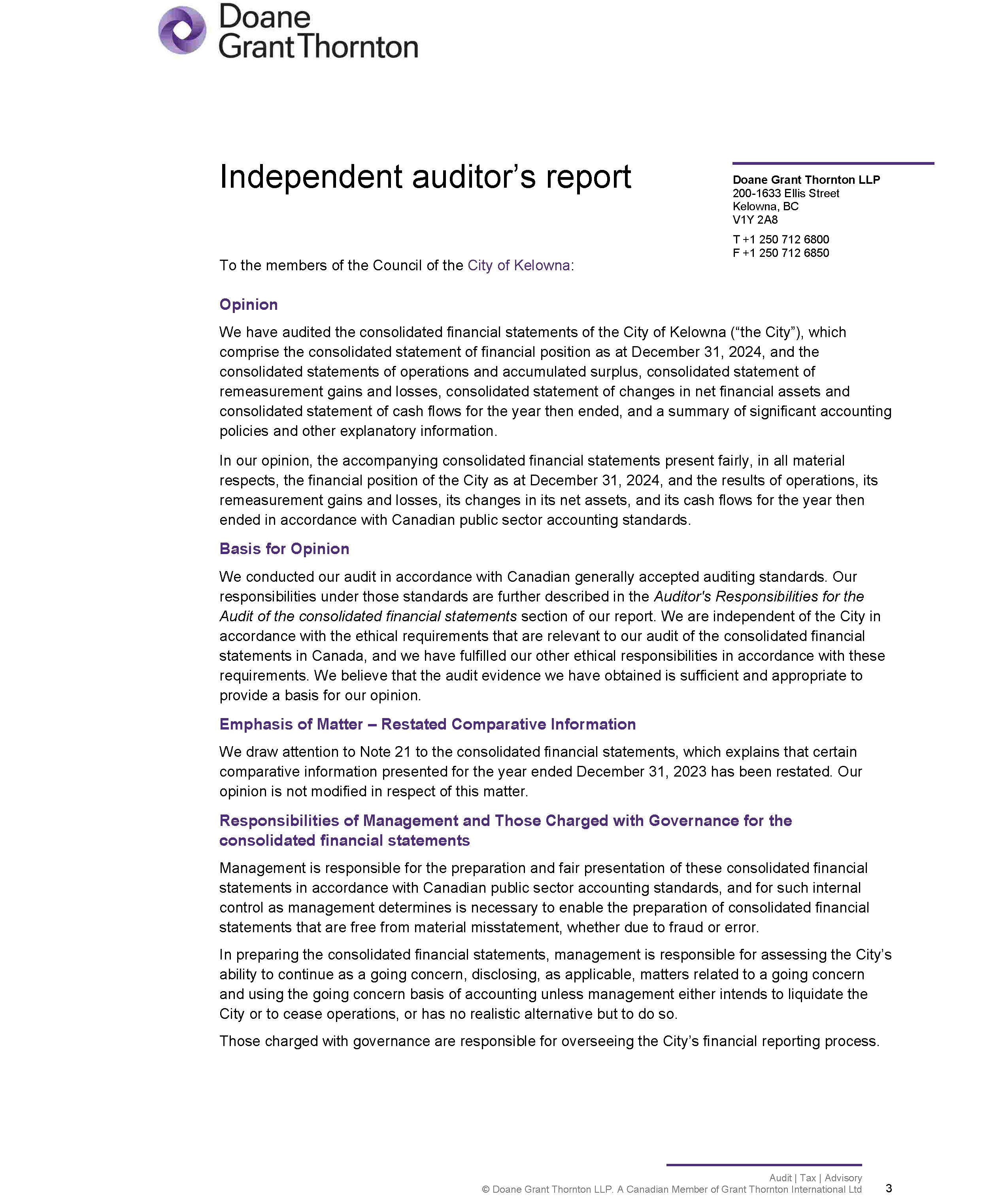
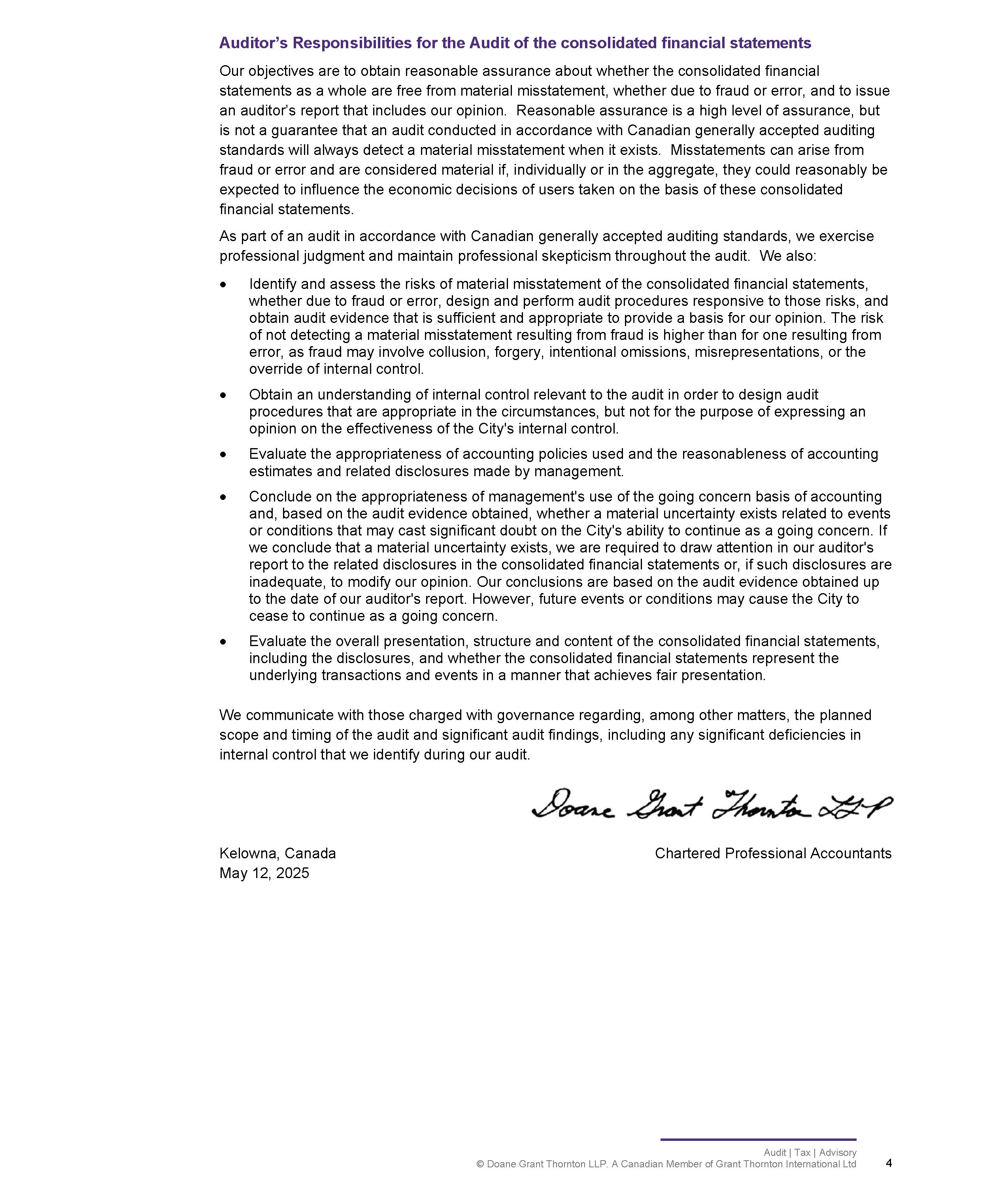


As at December 31, 2024 (in thousands of dollars)
and cash
(Note 3)
(Note 3)
(Note 3)
(Note 3)
Accumulated Surplus is comprised of:
(Note 3)
Contingent liabilities and Commitments (Notes 8 and 9) Contractual rights (Note 16) Subsequent event (Note 24)

Joe
Sass, CPA,
CA General Manager, Corporate Services
See accompanying notes to the consolidated financial statements.

Tom Dyas Mayor, City of Kelowna
For the Year Ended December 31, 2024 (in thousands of dollars)
For the Year Ended December 31, 2024 (in thousands of dollars)
Unrealized gains (losses) attributable to:
Realized (gains) losses reclassified to the consolidated statement of operations and accumulated surplus:
See accompanying notes to the consolidated financial statements
For the Year Ended December 31, 2024 (in thousands of dollars)
For the Year Ended December 31, 2024 (in thousands of dollars)
December 31, 2024
(in thousands of dollars)
The notes to the consolidated financial statements are an integral part of the statements. They explain the significant accounting and reporting policies and principles underlying these statements. They also provide relevant supplementary information and explanations which cannot be conveniently expressed in the consolidated financial statements.
The consolidated financial statements are the responsibility of and prepared by management in accordance with Canadian public sector accounting standards (PSAS). The preparation of these consolidated financial statements necessarily involves the use of estimates based on management’s judgment, particularly when transactions affecting the current accounting period cannot be finalized with certainty until future periods.
Basis of presentation
The consolidated financial statements reflect the assets, liabilities, revenues and expenses of the reporting entity. The reporting entity is comprised of all the organizations controlled by the City. Interfund and inter-corporate balances and transactions have been eliminated. The reporting entity includes the Kelowna Developments Ltd., a 100% subsidiary, which is currently inactive.
The resources and operations of the City are accounted for in the following funds: General, Airport, Wastewater Utility, Water Utility, Development Cost Charges and Statutory Reserve Funds.
The accrual method for reporting revenues and expenses has been used. Revenues are recognized in the period in which the transactions or events occur that give rise to the revenues. Expenses are recognized in the period in which the goods or services are acquired and a liability is incurred.
Assets held for sale are those expected to be sold within one year. Assets are valued at the lower of cost or expected net realizable value. Cost includes amounts for improvements required to prepare the asset for sale.
Cash and cash equivalents consist of cash and short-term investments with maturities of 90 days or less from the date of acquisition.
Inventory is valued at the lower of cost or net realizable value, determined principally on a weighted average and specific item basis, or replacement cost.
The City issues the majority of its debt instruments through the Municipal Finance Authority. As a condition of these borrowings, a portion of the debenture proceeds is withheld by the Municipal Finance Authority as a debt reserve fund. The City also executes demand notes in connection with each debenture whereby the City may be required to loan certain amounts to the Municipal Finance Authority. These demand notes are contingent in nature. The Debt Reserve and Demand Note balances are as follows:
The City of Kelowna and its employees participate in the Municipal Pension Plan. The Municipal Pension Plan is a multiemployer contributory defined benefit pension plan. Payments in the year are expensed as incurred.
Reserves for future expenditures are non-statutory reserves which represent an appropriation of surplus for specific purposes. Transfers to reserves for future expenditures include funds to finance incomplete projects and accumulations for specific purposes.
The use of these funds is restricted by the Community Charter and associated Municipal Bylaws. Statutory reserve funds are funded 100% by cash and portfolio investments.
Intangible assets are not reflected in these consolidated financial statements. They include works of art and historic assets located throughout the City.
The City of Kelowna only capitalizes interest on projects being financed internally which will require debenture borrowing upon completion. Interest is calculated on monthly expenditures at the bank prime rate less 2%.
Financial instruments give rise to the financial assets of one entity and financial liabilities or equity instruments of another entity and include cash and cash equivalents, accounts receivable, portfolio investments, accounts payable and accrued liabilities, long- term payable, and long-term debt. Portfolio investments represent funds held in the City of Kelowna pooled funds.
Financial instruments are initially measured at fair value and subsequently carried at fair value or cost or amortized cost.
• Fair value category: Investments quoted in an active market are reflected at fair value as at the reporting date. Sales and purchases of investments are recorded on the trade date.
Unrealized gains and losses on financial assets are recognized in the statement of remeasurement gains and losses until such time that the financial asset is derecognized due to disposal or impairment. At the time when a financial instrument in the fair value category is derecognized, the associated accumulated remeasurement gains and losses are reversed and reclassified to the statement of operations.
Transaction costs related to financial instruments recorded at their fair value are expensed as incurred.
• Cost category: Investments not quoted in an active market, financial assets and liabilities are recorded at cost or amortized cost (using the effective interest method).
Gains and losses are recognized in the statement of operations when the financial asset is derecognized due to disposal or impairment.
Transaction costs related to financial instruments measured at cost or amortized cost are added to the carrying value of the financial instrument.
Financial assets are assessed for impairment on an annual basis. If there is an indicator of impairment, the City determines if there is a significant adverse change in the expected amount or timing of future cash flows from the financial asset.
Financial instruments in the fair value category are classified as level 1, 2 or 3, as described below:
• Level 1: Quoted prices (unadjusted) in active markets for identical assets or liabilities.
• Level 2: Market-based inputs other than quoted prices that are observable for the asset or liability either directly or indirectly.
• Level 3: Inputs for the asset or liability that are not based on observable market data; assumptions are based on the best internal and external information available and are most suitable and appropriate based on the type of financial instrument being valued in order to establish what the transaction price would have been on the measurement date in an arm’s length transaction.
In the event that facts and circumstances indicate that the city's long-lived assets may be impaired, an evaluation of recoverability would be performed. Such an evaluation entails comparing the estimated future undiscounted cash flows associated with the asset to the asset's carrying amount to determine if a write down to market value or discounted cash flow value is required. The city considers that no circumstances exist that would require such an evaluation.
An asset retirement obligation is recognized when, as at the financial reporting date, all of the following criteria are met:
• There is a legal obligation to incur retirement costs in relation to a tangible capital asset;
• The past transaction or event giving rise to the liability has occurred;
• It is expected that future economic benefits will be given up; and
• A reasonable estimate of the amount can be made
The liability is initially recorded at the best estimate of the expenditures requires to retire a tangible capital asset, and the resulting costs are capitalized as part of the carrying amount of the related tangible capital asset if the asset is recognized and in productive use. This liability is subsequently reviewed at each financial reporting date and adjusted for any revisions to the timing or amount required to settle the obligation. The changes in the liability for the passage of time are recorded as accretion in the Statement of Operations and all other changes are adjusted to the tangible capital asset.
The landfill tangible capital asset is amortized using the units of production method, while the structures tangible capital assets, affected by the asbestos liability, are being amortized along with their respective assets following the amortization accounting policies outlined in Note 1.
Work in progress represents capital projects under construction but not yet completed and are valued at cost.
The City records tangible capital assets, including assets held as work in progress or capital lease, at cost in the period they were acquired or when the asset is put into use.
All tangible capital assets are valued at cost which includes all costs directly attributable to acquisition, construction, development or betterment of the tangible capital asset.
Assets owned by the City but not paid for by the City including contributions, dedications, gifts and donations, are valued at fair value at the date of contribution, dedication, gift or donation, where fair value is reasonably determinable.
Tangible capital assets received as contributions are recorded at their fair market value at the date of contribution, where fair value is reasonably determinable.
The cost less residual value of the tangible capital assets is amortized on a straight-line basis over the useful lives of the asset as follows:
Land and Work in Progress are not amortized.
Revenue recognition
Taxation revenue
Annual levies for non-optional municipal services and general administrative services are recorded as taxes for municipal purposes. Levies imposed by other taxing authorities are not included as taxes for municipal purposes. Taxes are recognized as revenue in the year they are levied.
Through the BC Assessment appeal process taxes may be adjusted by way of supplementary roll adjustments. The effect of these adjustments on taxes are recognized at the time they are awarded.
Development Cost Charges (DCC) contributions
Development Cost Charges (DCC) contributions are recognized as revenue during the period in which the related costs are incurred. Development cost charges collected or collectible, but not yet expended, are recorded as unearned revenue.
Government transfers
Government transfers are recognized as revenue in the consolidated financial statements when the transfer is authorized and any eligibility criteria are met, except to the extent that transfer stipulations give rise to an obligation that meets the definition of a liability. Transfers are recognized as deferred revenue when transfer stipulations give rise to a liability. Transfer revenue is recognized in the statement of operations as the stipulation liabilities are settled.
Fees and charges revenue
Charges for transportation, environmental health, building permits, water, wastewater, and airport are included in this category. These revenues are recorded on the accrual basis and recognized when performance obligations are met, which is usually when services are provided or facilities are utilized.
Investment income
The City’s investments are disclosed in Note 3.
Investment income is recorded on the accrual basis and recognized when earned.
A portion of the City’s investments are invested in pooled funds of the Municipal Finance Authority of British Columbia. Earnings on these funds are allocated to the members from time to time based on the market value of the pool. The City recognizes only its share of the realized earnings of the pool. This revenue is recorded as investment income and the amount is added to the cost base of the investment.
To the extent that investments have no stated rate of return, investment income is recognized as it is received.
Fees and charges and investment income transactions with performance obligations are recognized when the City satisfies the performance obligations, which occur when control of the benefits associated with the promised goods and services have passed to a payor. Transactions without performance obligations are recognized at realizable value when the City has the authority to claim or retain an inflow of economic resources and a past event has occurred.
Expenses
Expenses are recorded in the period in which the goods or services are acquired and a liability is incurred.
Contaminated sites are a result of contamination being introduced into air, soil, water or sediment of a chemical, organic or radioactive material or live organism that exceeds an environmental standard. The liability is recorded net of any expected recoveries. A liability for remediation of contaminated sites is recognized when a site is not in productive use and all the following criteria are met:
• An environmental standard exists;
• Contamination exceeds the environmental standard;
• The City is directly responsible; or accepts responsibility;
• It is expected that future economic benefits will be given up; and
• A reasonable estimate of the amount can be made.
The liability is recognized as management’s estimate of the cost of post -remediation including operation, maintenance and monitoring that are an integral part of the remediation strategy for a contaminated site.
Public-private partnership (“P3”) projects are delivered by private sector partners selected to design, build, finance, and maintain the assets. The cost of the asset under construction is included in work in progress at cost. When available for operation, the project assets are amortized over their estimated useful life. Correspondingly, an obligation for the cost of capital and financing received to date, net of contributions paid, is recorded as a liability and included in debt. The contract rate on financing was determined using the weighted average cost of capital specific to the public private partnership arrangement. Upon substantial completion, the private partner receives payments for community use time as well as revenue from third party users to cover the partner's operating cost, financing cost and a return of their capital over the term of the agreement.
Management has made estimates and assumptions that affect the amounts reported in preparing these financial statements. Actual results could differ from the estimates. Significant areas requiring the use of management estimates relate to the determination of asset retirement obligations, the value of contributed tangible capital assets, tangible capital assets estimated useful life and related amortization, allowance for doubtful accounts, contaminated site liabilities, and settlement costs associated with outstanding legal actions.
PS 3400 Revenue and PS 3160 Public-Private Partnerships
Effective January 1, 2024, The City of Kelowna adopted new accounting standards issued by the Public Sector Accounting Board, including PS 3400 Revenue and PS 3160 Public-Private Partnerships.
• PS 3400 Revenue establishes principles for recognizing revenue in public sector entities, distinguishing between exchange and non-exchange transactions. Exchange transactions involve one or more performance obligations, requiring the transfer of goods or services to a payor in exchange for consideration, whereas non-exchange transactions do not have a direct transfer of goods or services.
• PS 3160 Public Private Partnerships can exist in transactions where public sector entities procure infrastructure using private sector partners. The standard provides guidance on the recognition, measurement, presentation, and disclosure of transactions rela ted to public-private partnerships.
The City has applied PS 3400 prospectively, meaning prior periods have not been restated.
PS 3160 was applied retroactively, without restatement of prior periods. The adoption of this standard resulted in the following adjustments as of January 1, 2024:
• An increase to buildings capital assets of $18,500
• An increase in buildings accumulated amortization of $9,065
• A decrease in long term investments of $6,000
• An increase in long term debt of $2,850
• An increase in accumulated surplus for the year of $585
• A decrease in net assets of $8,850
Cash and cash equivalents
The City has an operating line of credit with the Royal Bank of Canada for an authorized amount of $5,000 bearing interest at bank prime rate. At December 31, 2024 the balance outstanding was $nil (2023 - $nil).
Included in portfolio investments are designated assets related to the City’s Legacy Endowment Fund. At December 31, 2024 the fair market value of these internally restricted funds was $180,883 (2023 - $157,821)
The City records deferred revenue for funds received in advance of services not yet rendered and is recognized into revenue during the period in which the service is provided. The City also records deferred revenue when a contract specifies how the resources are to be used and therefore funds received in advance are deferred until the period in which the requirements are met. Because these funds are restricted in nature they are shown as a liability.
The City collects development cost charges to pay for a proportionate share of infrastructure related to new growth. In accordance with the Local Government Act, these funds must be deposited into a separate reserve fund. Because these funds are externally restricted in nature they are shown as a liability.
Local governments are permitted to temporarily lend available money from one DCC reserve fund to another. The money, along with appropriate interest, must be returned to the original reserve fund.
Sinking fund installments and mortgage payments on net outstanding debt and loans payable over the next five years and thereafter are as follows:
Total outstanding debt issued was $154,371 and total debt payable at December 31, 2024 was $57,988 (2023 - $65,720).
Total interest paid in 2024 was $5,089 (2023 - $4,907).
Schedule 3 provides a breakdown of long term debt.
Contributions received in 2024 include:
Schedule 1 provides a break down of tangible capital assets and work in progress.
During the year, tangible capital assets with a cost of $355 (2023 - $1,211) were written off due to impairment.
During the year, no interest was capitalized $nil (2023 - $nil).
Accumulated Surplus detail as follows:
Taxation revenue comprises the following amounts raised less transfers to other governments:
Government transfers are the major source of transfers to the City. Government transfers received are for completed projects that meet the required criteria as set out by the Government body providing the funding. Government transfers do not include grants in lieu of taxes received from the Federal and Provincial governments. During the year $777 (2023$22,825) remained as deferred revenue for future expenditures. In 2024 the City received and recorded as revenue the following transfers:
Regional District of Central Okanagan
Regional District debt is, under the provisions of the Local Government Act, a direct, joint and several liability of the District and each member municipality within the District including the City of Kelowna.
The loan agreements with the Regional District of Central Okanagan and the Municipal Finance Authority provide that if at any time the scheduled payments provided for in the agreements are not sufficient to meet the Authority's obligation with respect to such borrowing, the resulting deficiency becomes a liability of the member municipalities.
The City of Kelowna does not accrue expenses for post -employment benefits and compensated absences. Post-employment benefits are benefits expected to be provided after employment but before retirement to employees and their beneficiaries. Compensated absences are benefits for employee absences for which employees will be paid (i.e. sick leave). City employees retiring do not receive any post-employment related benefits that either vests or accrues over the period of employment.
Compensated absences: such as sick leave benefits do not accrue and are not vested. The City recognizes the expense for compensated absences when the event obligates the City to pay.
The City of Kelowna is currently engaged in certain legal actions, the outcome of which is not determinable at this time. Accordingly, no provision has been made in the accounts for these actions.
The amount of loss, if any, arising from these contingent liabilities will be recorded in the accounts in the period in which the loss is realized. The City of Kelowna has insurance policies and financial reserves to offset associated risks.
The City has entered into various agreements and contracts for services and construction projects. As of December 31, 2024, the City has open purchase orders that have outstanding commitments. The total balance of these commitments are currently undetermined. They span multiple years, and funding for these obligations has been allocated to reserves. The commitments will be reduced and the expense will be recorded upon receipt of the related goods and services.
The City has, under the terms of the partnering agreement between the City of Kelowna and YMCA of Southern Interior BC, guaranteed repayment in the event that the YMCA of Southern Interior BC defaults on a $1,800 20-year loan issued in 2001. Under the agreement the City shall resume operation of the facility and assume responsibility for the repayment of the debt incurred by the YMCA of Southern Interior BC. During 2010 an amendment was made to the agreement for additional financing of $700 for a 20-year term. Both loans have an interest rate of prime minus 0.5%. As at December 31, 2024, the outstanding loan balance was $378 (2023 - $431). The City does not expect to make any payments on the guarantee and no amounts have been accrued in the financial statements.
The Province of British Columbia and the Federal Government have an agreement with the Royal Canadian Mounted Police to provide police services for various municipalities in the Province, including the City of Kelowna. This agreement has a 20 year term expiring on March 31, 2032.
The City of Kelowna entered into a Tripartite Agreement in 1999 with the Royal Bank of Canada, RG Arenas (Kelowna) Ltd., RG Properties Ltd., and Prospero Canadian Land Investment Fund Ltd. group of companies. Under this agreement, the private sector partner designed, built, financed, and maintained the multi-purpose facility. The multi-purpose facility was capitalized and is included in the City's tangible capital assets. The public-private partnership debt associated with this facility is included in the City's long-term debt (Schedule 3). The loan is repaid through a combination of a portion of the City’s community use time payments and revenue through the user pay model for non community use time. As part of the agreement, the City invested $6,000 in preferred shares with RG Arenas (Kelowna) Ltd. representing the City's investment in the Multi-Purpose facility. This investment was a required payment under the agreement and was recorded as a reduction of the public-private partnership debt. The City has the option to purchase the facility for $1.00 and surrender the preferred shares within the 10year period beginning 30 years and one week from the date of substantial completion (November 19, 2029).
As part of the agreement the City committed to the annual purchase of community use time at the Multi-Purpose Facility with the option to make a lump sum payment before the 15th day of one of the years 6, 11, 16, 21, 26, commencing with the year of substantial completion (November 10, 1999).
In 2019 (Year 21), the City exercised its option to make a lump sum payment of $6,727 as prepayment for community use time. Consequently, no further amounts are payable under the Tripartite Agreement until November 9, 2029. The balance of $3,364 (2023 - $4,036) in prepaid community use time is included in prepaid expenses.
In addition to the performance deposits reflected in cash balances, the City is holding irrevocable Letters of Credit in the amount of $92,725 (2023 - $89,908) which were received from depositors to ensure their performance of works to be undertaken within the City. These amounts are not reflected in the financial statements but are available to satisfy any liabilities arising from non-performance by the depositors. Included in the $92,725, the City is holding irrevocable Letters of Credit in the amount of $18,931 (2023 - $23,932) which are received from developers to ensure payment of development cost charges in future years.
In accordance with PSAS, trust funds are not included in the City’s consolidated financial statements. The City administers a Cemetery Perpetual Care Fund for the perpetual care and maintenance of the City owned and operated cemetery. As at December 31, 2024 the Trust Fund balance is $4,096 (2023 - $3,796).
The City of Kelowna is connecting communities and providing a multitude of services to the citizens of Kelowna. The City’s operations and activities are organized and reported by funds and departments. The General Fund reports on operations, funded primarily by property taxes, which include services provided by the City such as general government, protective services, transportation services, recreation and cultural services, as well as public health, and environmental and development services. The City also operates the Kelowna International Airport (the Airport) and City utilities comprised of the wastewater and water systems that are self-sustaining operations. Operating results reported by the following segments are included in Schedule 2.
General government
General Government operations are primarily funded by property taxation and business tax revenues. The general revenue reported under this segment includes revenues associated with taxation, business tax revenues and senior government payments in lieu of taxes. These revenues have not been apportioned to other departments supported by the General Fund. The expenses within this segment are for executive and legislative costs, general administration, and other general government areas such as community service grants and rental property operating costs within the municipality.
Protective services are comprised of fire protection services, building inspection services, bylaw enforcement and police services provided by the Royal Canadian Mounted Police.
The fire department is responsible for effective fire protection and public safety services to the City. This includes fire suppression and rescue, prevention and investigation, specialty rescue/first medical responses and fire safety inspections. Police services, provided by the Royal Canadian Mounted Police, include administration, crime investigation and prevention, traffic, prisoner custody and court liaison expenses.
Transportation services are responsible for the delivery of municipal public works services related to the planning, development and maintenance of streets and roads; bridges; drainage systems; street lights; traffic lights and signals; parking lots and on-street parking; and public transit as well as maintenance of workshops, yards and other buildings. The mandate is to provide a safe, efficient, environmentally-sensitive and cost-effective transportation network.
Recreation and cultural services
Recreation and cultural services are comprised of services related to recreation, leisure and culture including administration and program costs as well as grounds and building maintenance. Facilities managed within this segment include parks and playgrounds, arenas, swimming pools, beaches, boat launches, stadiums as well as community and multi-age activity centers. Some of the larger facilities that the City owns and/or operates include the H2O Adventure & Fitness Centre, Parkinson Recreation Centre, Kelowna Community Theatre, Kelowna Museums Society, Kelowna Library, Kelowna Art Gallery, MNP Place and the Rotary Centre for the Arts.
Other services (Public Health/Environmental/ Development services)
Public health services are comprised of cemetery operations and maintenance, environmental and development services including community planning and zoning as well as landfill operations.
Airport services
The Airport, owned and operated by the City of Kelowna, is a regional economic driver that connects passengers to domestic and international destinations in compliance with Federal regulations. The Airport is self-funded, provides a payment in lieu of property taxes to the City of Kelowna, and is accounted for in its own fund.
Wastewater services
Kelowna’s wastewater system collects, conveys, treats and disposes of domestic wastewater (derived from the home) and industrial wastewater (resulting from business use, manufacturing and processing). The system currently services approximately 75% of Kelo wna’s population and expansion to unserviced areas continues. Kelowna’s wastewater system has a treatment capacity of 70 million litres per day. Wastewater Utility is accounted for in its own fund.
Water services
The Water Utility is responsible for planning, expansion, operation and maintenance of the City’s Water Supply System and is one of four water suppliers operating within Kelowna’s boundaries. The Water Utility is accounted for in its own fund.
Statutory reserves
Statutory Reserves include funds for parking, land, capital works, machinery and equipment, and public amenities.
Total consolidated expenses by object are itemized in Schedule 2 – Segmented information.
The budget figures are from the Annual Five-Year Financial Plan Bylaw adopted before May 15th of each year. Subsequent amendments have been made by Council to reflect changes in the budget as required by law. The table below reconciles the statutory financial plan and the financial plan surplus presented on the Consolidated Statement of Operations:
Budget Amount
Financial
Lease revenue
The City of Kelowna contractual rights arise from rights to receive payments from lease agreements. During 2020, the City of Kelowna entered into a long term lease agreement with Rise Commercial Developments Inc to lease 350 Doyle Avenue commencing in 2021. The long term lease is for $7,000 to be received over 80 years with an option to renew for an additional 19 years.
As of December 31, 2024, the City of Kelowna had received a $2,700 prepayment with the remaining balance of $4,300 in the form of non-cash consideration, estimated to be received in 2026.
Airport sublease revenue
The Airport’s contractual rights arise from rights to receive payments from sublease agreements. During 2023, the Airport entered into two long-term sublease agreements which include the construction of a hotel (“the hotel sublease”), and a parkade structure (“the parkade sublease”), with lease payments commencing upon substantial completion of the buildings. The long-term leases expire on December 31, 2054, with an automatic extension up to 99 years upon renewal of the Airport’s Ground Lease with the Government of Canada.
Under the hotel sublease, the Airport expects to receive a prepayment of $2,333, estimated to be received in 2025, with the remaining consideration of $124 annually estimated to commence in 2026. Annual revenues under the parkade sublease are estimated to commence beginning in 2026, but cannot be reasonably estimated at this time.
Risk management of financial instruments
The City of Kelowna has exposure to the following risks related to its financial instruments: credit risk, liquidity risk, interest rate risk, foreign exchange rate risk, and other price risk.
The City employs various risk management strategies to identify and mitigate these risks.
Credit Risk
Credit risk is the risk that one party to a financial instrument will fail to meet its contractual obligation and cause a financial loss for the other party. The City is primarily exposed to credit risk on its cash and cash equivalents, accounts receivable and portfolio investments. The Government’s carrying amounts for these financial assets best represent its maximum exposure to credit risk.
For cash and cash equivalents, and portfolio investments, the City manages this risk by dealing solely with reputable financial institutions, and through an investment policy that limits investments to high credit quality as well as maintains asset allocation and portfolio diversification. For accounts receivable, the City reviews balances and aging information to determine if a valuation allowance is necessary, and initiates collection actions.
Liquidity risk
Liquidity risk is the risk that the City will encounter difficulty in meeting obligations associated with financial liabilities. The City is exposed to liquidity risk on its accounts payable and accrued liabilities and long-term debt.
The City manages its overall liquidity risk by managing cash resources which is achieved by monitoring actual and forecasted cash flows. The City manages this risk on its borrowings by applying limits to its debt capacity and distributing debt maturities over many years (Schedule 3).
Interest rate risk is the risk that the fair value or future cash flows of a financial instrument will fluctuate unfavourably with changes in market interest rates.
The City is exposed to interest rate risk through its portfolio investment holdings in interest-bearing, or fixed -income assets which may include GICs, term deposits, and funds that include debt securities of Canadian Governments and corporate issuers. The City manages this risk by holding interest bearing instruments to maturity.
Foreign exchange rate risk is the risk that the fair value or future cash flows of a financial instrument will fluctuate unfavourably with a change in the value of the Canadian dollar relative to other currencies. The City is not exposed to any significant foreign exchange risk because instruments held in foreign currency are not considered significant.
Other Price risk is the risk that the fair value or future cash flows of a financial instrument will fluctuate because of changes in market prices (other than those arising from interest rate or currency risk). The City is exposed to other price risk through its portfolio investments and manages these risks through maximum proportions of equities in its investment portfolio and through concentration limits on investments in any one issuer, as outlined in the investment policy.
The City is not involved in any hedging relationships through its operations and does not hold or use any derivative financial instruments for trading purposes. Overall, the other price risk is not considered significant.
The City's asset retirement obligations consist of several obligations as follows:
a) Landfill obligation:
The City owns and operates a landfill site. The liability for the closure of the operational site and post-closure care has been recognized under PS 3280 Asset Retirement Obligations. The costs were based upon the presently known obligations that will exist at the estimated year of closure of the site and for 200 years post this date. The landfill had an estimated useful life of 160 years when it was purchased, of which 102 years remain. Post-closure care is estimated to be required for 200 years from the date of site closure. These costs were discounted to December 31, 2024 using a discount rate of 4.43% (2023 –4.41%) per annum.
b) Asbestos obligation:
The City owns and operates structures that are known to have asbestos, which represents a health hazard upon demolition of the building and there is a legal obligation to remove it. The City recognized an obligation relating to the removal and postremoval care of the asbestos in these structures. Post-closure care is estimated to extend for up to a year post the closure of the structure, while demolition and construction continues. Estimated costs have been discounted to the present value using a discount rate of 4.43% (2023 – 4.41%) per annum.
Changes to the asset retirement obligation in the year are as follows:
In early 2020 the City acquired 1746 Water Street and accepted responsibility to clean up contamination found at the site. Clean up activities took place in 2020-2024 and further work will be undertaken in 2025 to remediate the site. This will consist of groundwater and vapour monitoring and sampling, drilling investigation and monitoring to assess plume stability and seasonality. A liability in the amount of $93 (2023 - $36) is based on contractor estimates of the remaining work required to be undertaken.
The City’s liability of $93 (2023 - $36) for contaminated sites is included in accounts payable and accrued liabilities.
In addition, the City owns two potentially remediated sites. At this point the City has not recognized these obligations, as the level of contamination is unknown. The total expected future costs of remediation and post remediation will be recognized as a liability in the period when their value can be reasonably estimated.
The employer and its employees contribute to the Municipal Pension Plan (a jointly trusteed pension plan). The board of trustees, representing plan members and employers, is responsible for administering the plan, including investment of assets and administration of benefits. The plan is a multi-employer defined benefit pension plan. Basic pension benefits are based on a formula. As at December 31, 2023, the plan has about 256,000 active members and approximately 129,000 retired members. Active members include approximately 45,000 contributors from local governments.
Every three years, an actuarial valuation is performed to assess the financial position of the plan and adequacy of plan funding. The actuary determines an appropriate combined employer and member contribution rate to fund the plan. The actuary’s calculated contribution rate is based on the entry-age normal cost method, which produces the long-term rate of member and employer contributions sufficient to provide benefits for average future entrants to the plan. This rate may be adjusted for the amortization of any actuarial funding surplus and will be adjusted for the amortization of any unfunded actuarial liability.
The most recent valuation for the Municipal Pension Plan as at December 31, 2021, indicated a $3.8 billion funding surplus for basic pension benefits on a going concern basis.
The next valuation will be as at December 31, 2024.
The City of Kelowna paid $10,243 (2023 - $8,764) for employer contributions while employees contributed $8,911 (2023$7,661) to the plan in fiscal 2024.
Employers participating in the plan record their pension expense as the amount of employer contributions made during the fiscal year (defined contribution pension plan accounting). This is because the plan records accrued liabilities and accrued assets for the plan in aggregate, resulting in no consistent and reliable basis for allocating the obligation, assets and cost to individual employers participating in the plan.
The City has determined that the developer contributed tangible capital assets had not been recognized in the City's tangible capital assets and revenue since 2009. As such, both the revenue and tangible capital assets had been understated in the prior years. As a result of the correction, the following financial statement items as at December 31, 2023 have been adjusted as below:
Certain comparative figures have been reclassified to conform to the presentation format adopted in the current year.
The Conceptual Framework for Financial Reporting in the Public Sector
The PSAB issued The Conceptual Framework for Financial Reporting in the Public Sector, which replaces the conceptual aspects of Section PS 1000, Financial Statement Concepts and Section PS 1100, Financial Statement Objectives. This conceptual framework applies to fiscal years beginning on or after April 1, 2026, with early adoption permitted.
This section revises and replaces the existing PS 1201 Financial Statement Presentation. This section applies to fiscal years beginning on or after April 1, 2026, with early adoption only permitted if The Conceptual Framework for Financial Reporting in the Public Sector is also adopted at the same time.
Subsequent to the year end, the Glenmore Ellison Improvement District (GEID) officially joined the City of Kelowna on January 1, 2025, with a full transition expected by 2028.
In March 2024, the GEID board unanimously signed a Transition Agreement with the goal of transferring the operation of GEID to the City of Kelowna. An Order in Council was signed by the Province in June 2024, making the transition official.
For the Year Ended December 31, 2024 (in thousands of dollars)
Amortization
< Table continues from previous page
For the Year Ended December 31, 2024 (in thousands of dollars)
For the Year Ended December 31, 2023 (in thousands of dollars)
For the Year Ended December 31, 2024 (in thousands of dollars)
For the Year Ended December 31, 2024 (in thousands of dollars)
For the Year Ended December 31, 2024 (in thousands of dollars)
The COVID-19 Safe Restart Grant was received from the Provincial Government in 2020. The schedule below provides disclosure of funds received, spent and remaining as well as any interest earned on unused funds. A balance at the end of the year represents unused funds received and is included in the General fund reserve.
For the Year Ended December 31, 2024 (in thousands of dollars)
The BC Growing Communities Fund Grant was received from the Provincial Government in 2023. The schedule below provides disclosure of funds received, spent and remaining as well as any interest earned on unused funds. A balance at the end of the year represents unused funds received and is included in the General fund reserve. 2024 2023


2020-2024
Population
High school certificate or equivalent

University certificate or diploma below the bachelor level

University certificate or degree
Age of Population 2024
College, CEGEP or other nonuniversity certificate or diploma

Apprenticeship or trades certificate or diploma

No certificate, diploma or degree








Natural resources, agriculture and related production (2,260) Natural and applied sciences related (5,325) Health (7,710) Education, law and social, community and government services (8,710) Legislative and senior management (900)


Sources: The population and age of population statistics on this page are updated each year from data from Environics. The education and occupation graphs on this page are updated from Census information available every 5 years, with 2021 being the last available.
Unemployment Rate for Kelowna
Source: Statistics Canada, Labour Force Survey as prepared by BC Stats: BC Unemployment Rate by Region
Number of City of Kelowna Employees
Note: Full time employees at the City of Kelowna
Revenues by Source
Consolidated Expenses by Function
General Debenture Debt Charges as a Percentage of Total General Expenditures
Consolidated Debt as a Percentage of Total General Expenditures
Consolidated Expenses by Object millions
for General Taxation
Property Tax Levies
Total Current Year Property Taxes Collected thousands

